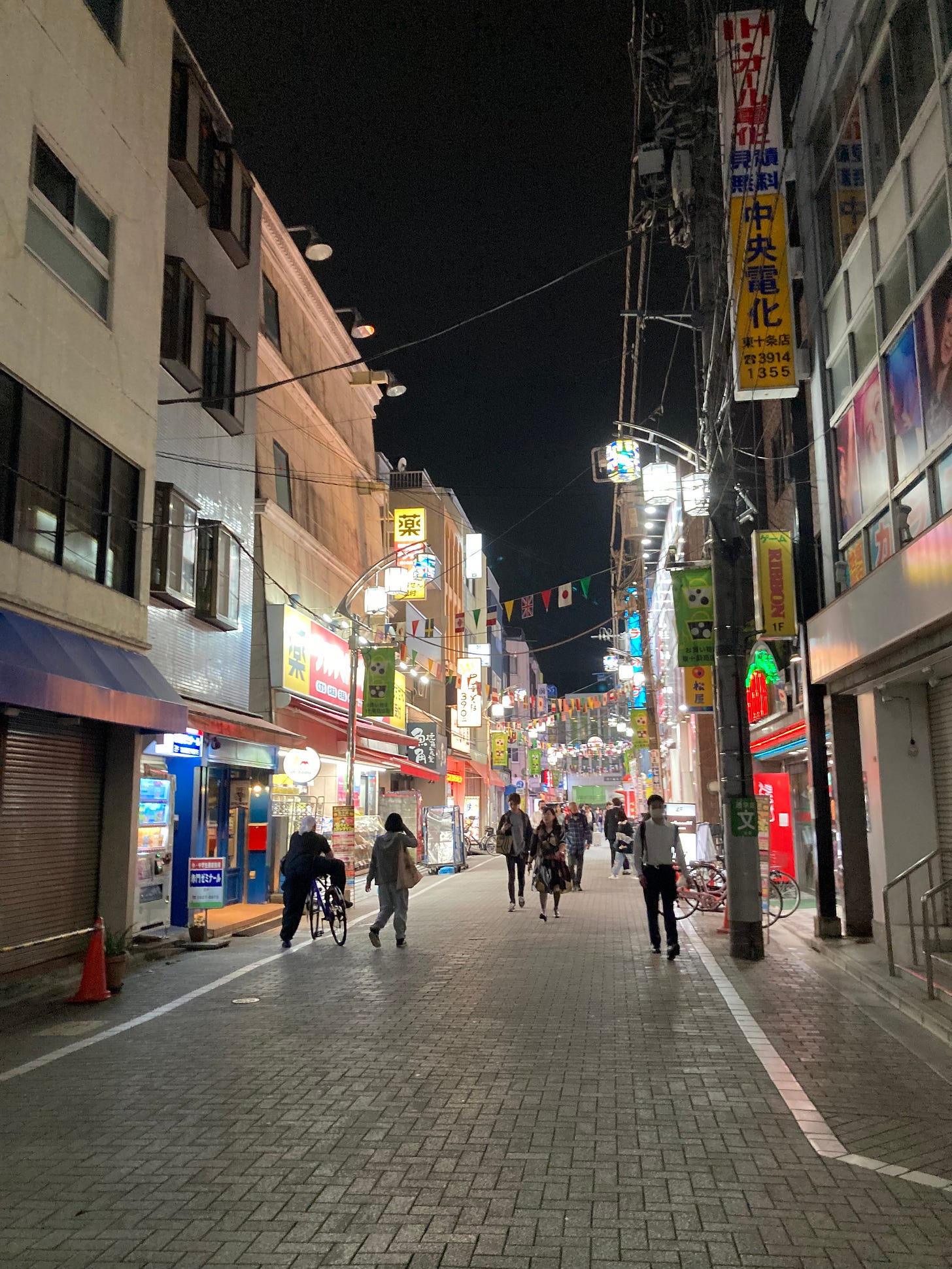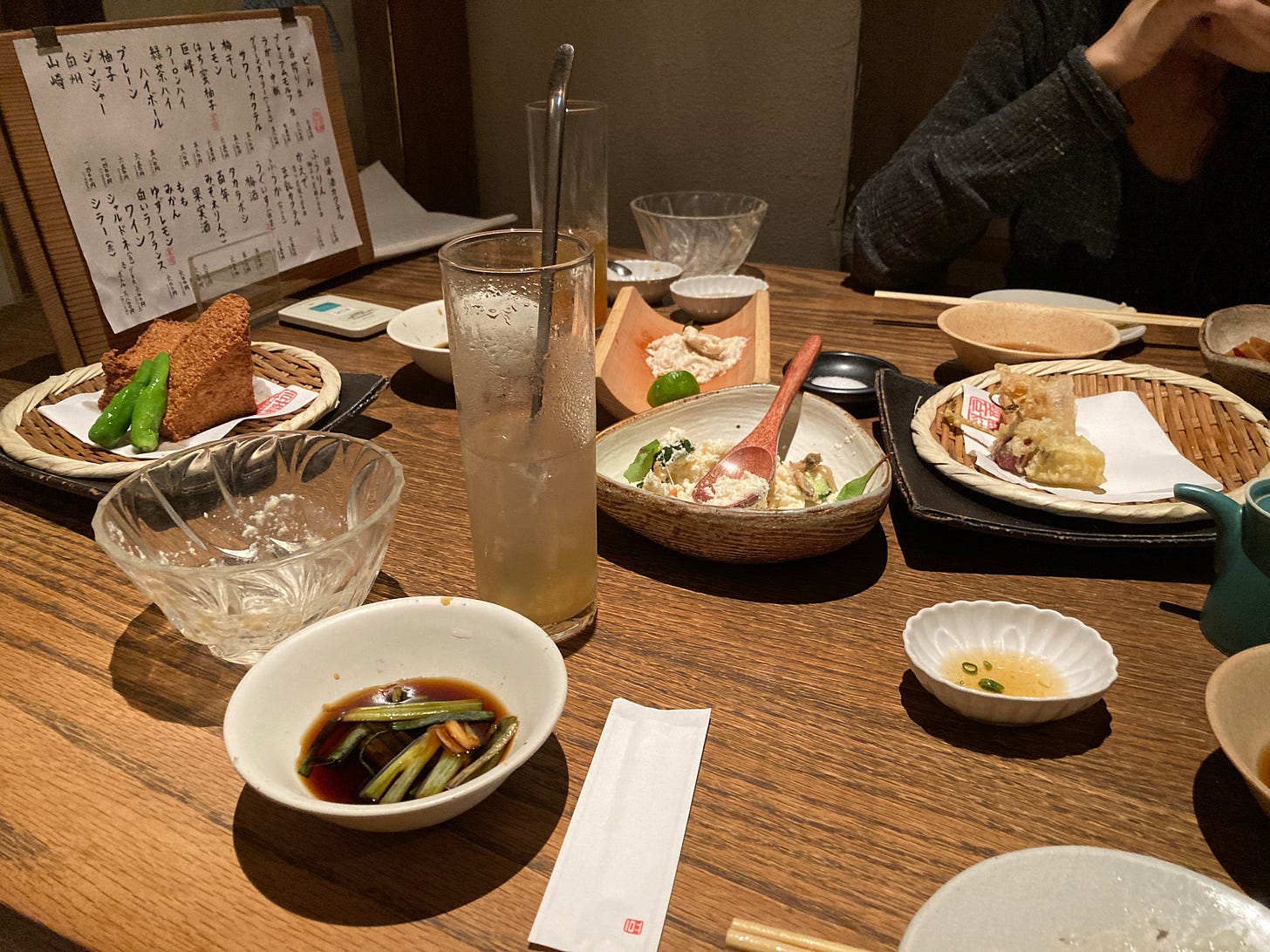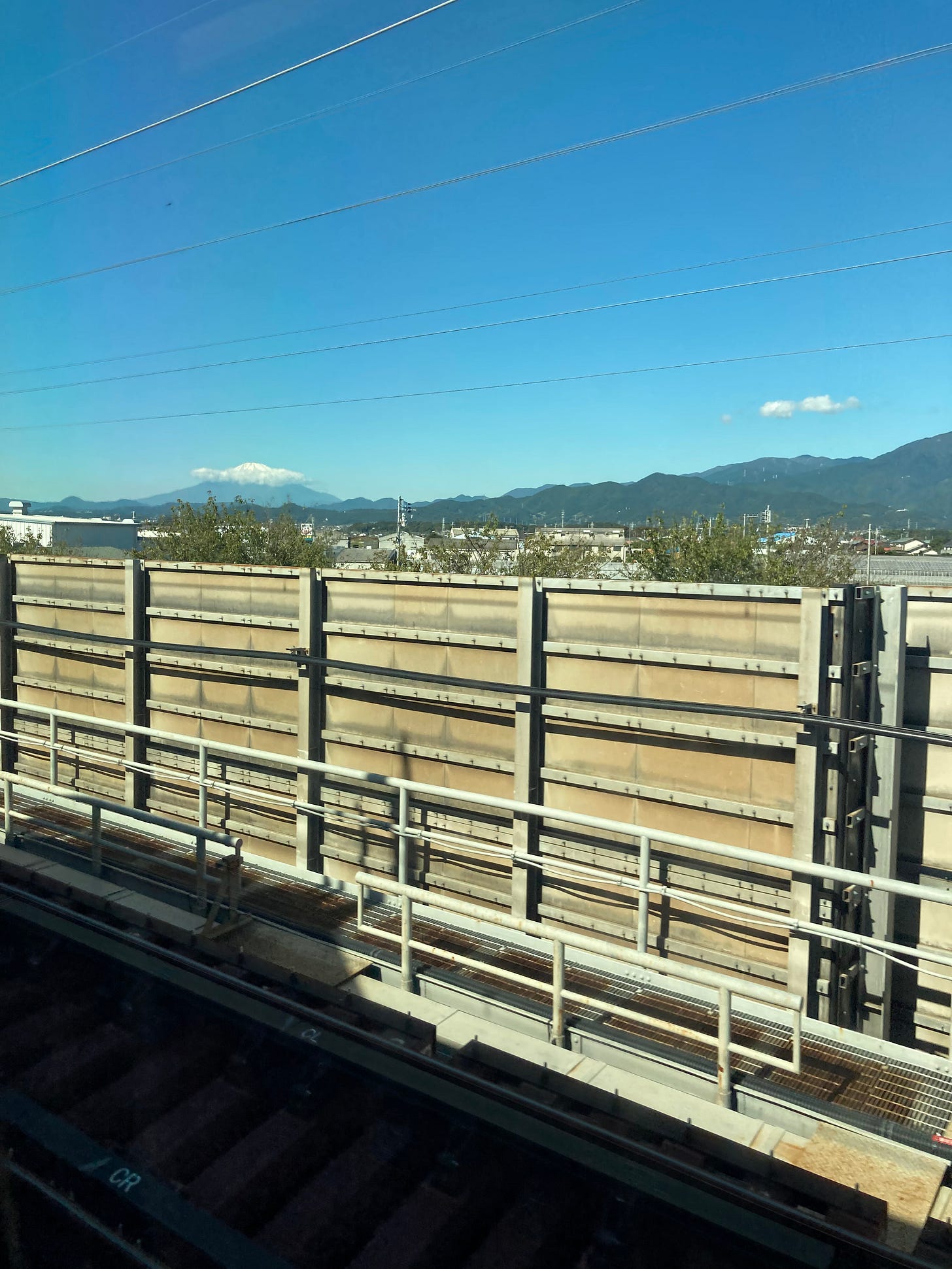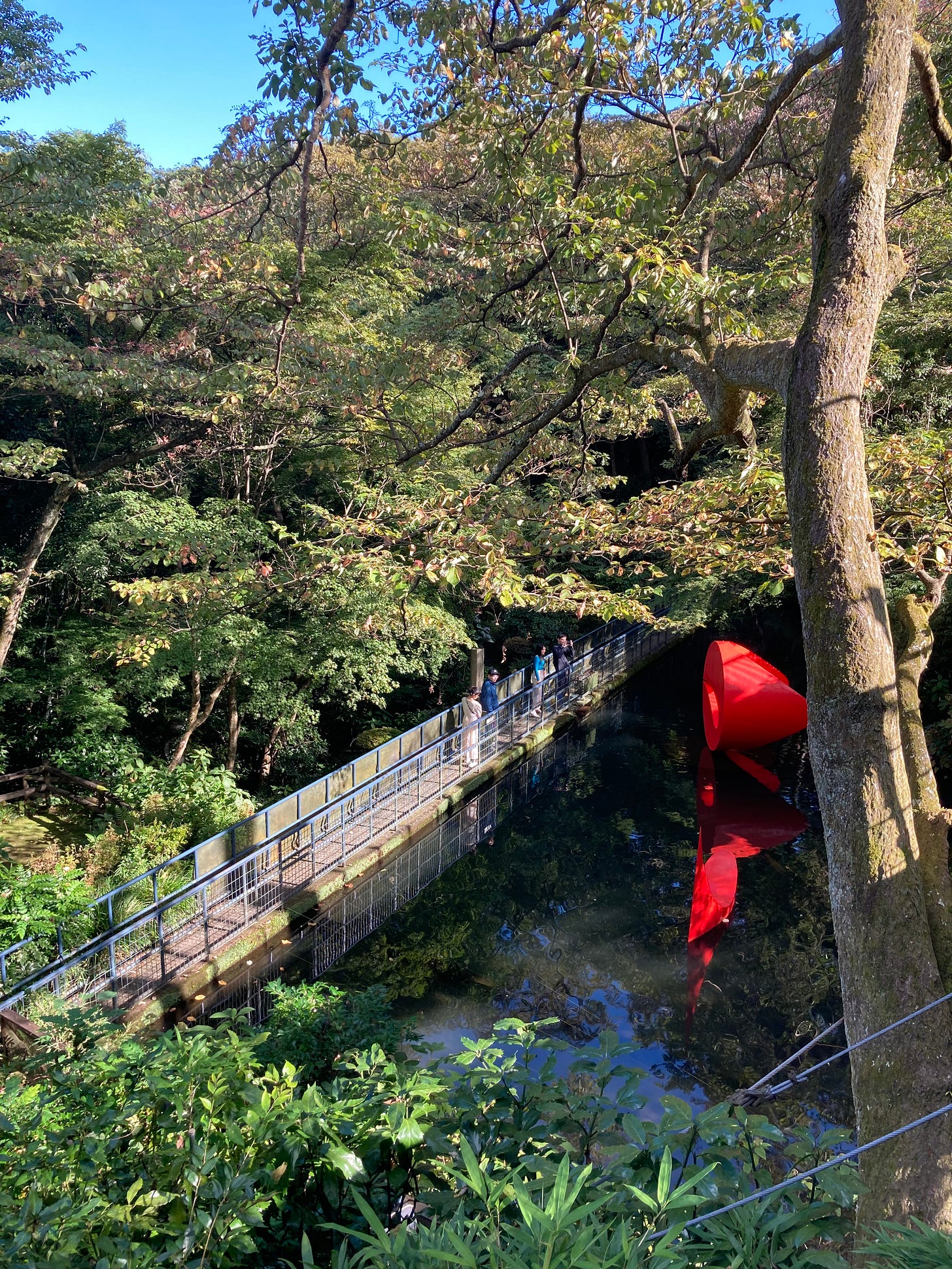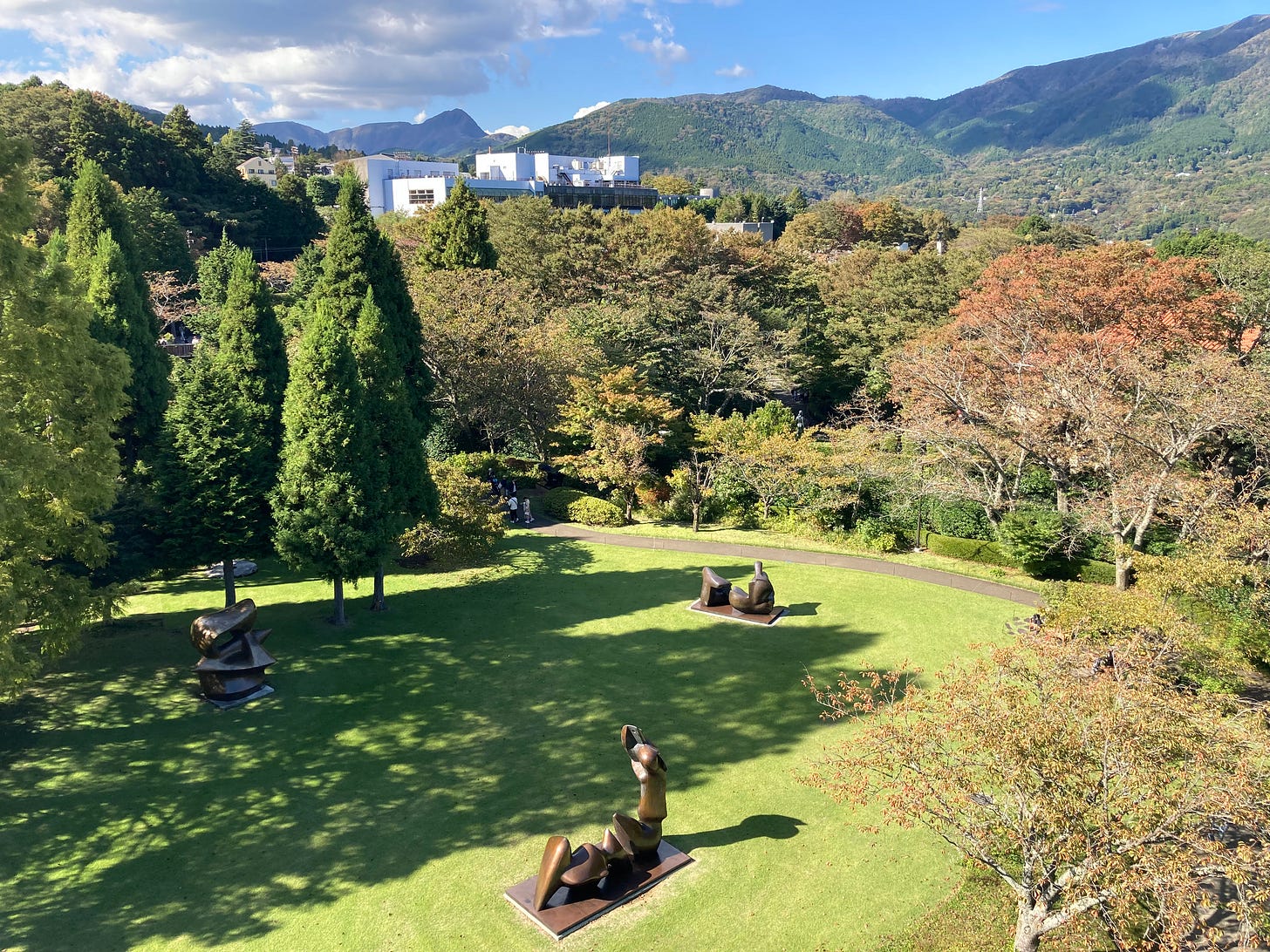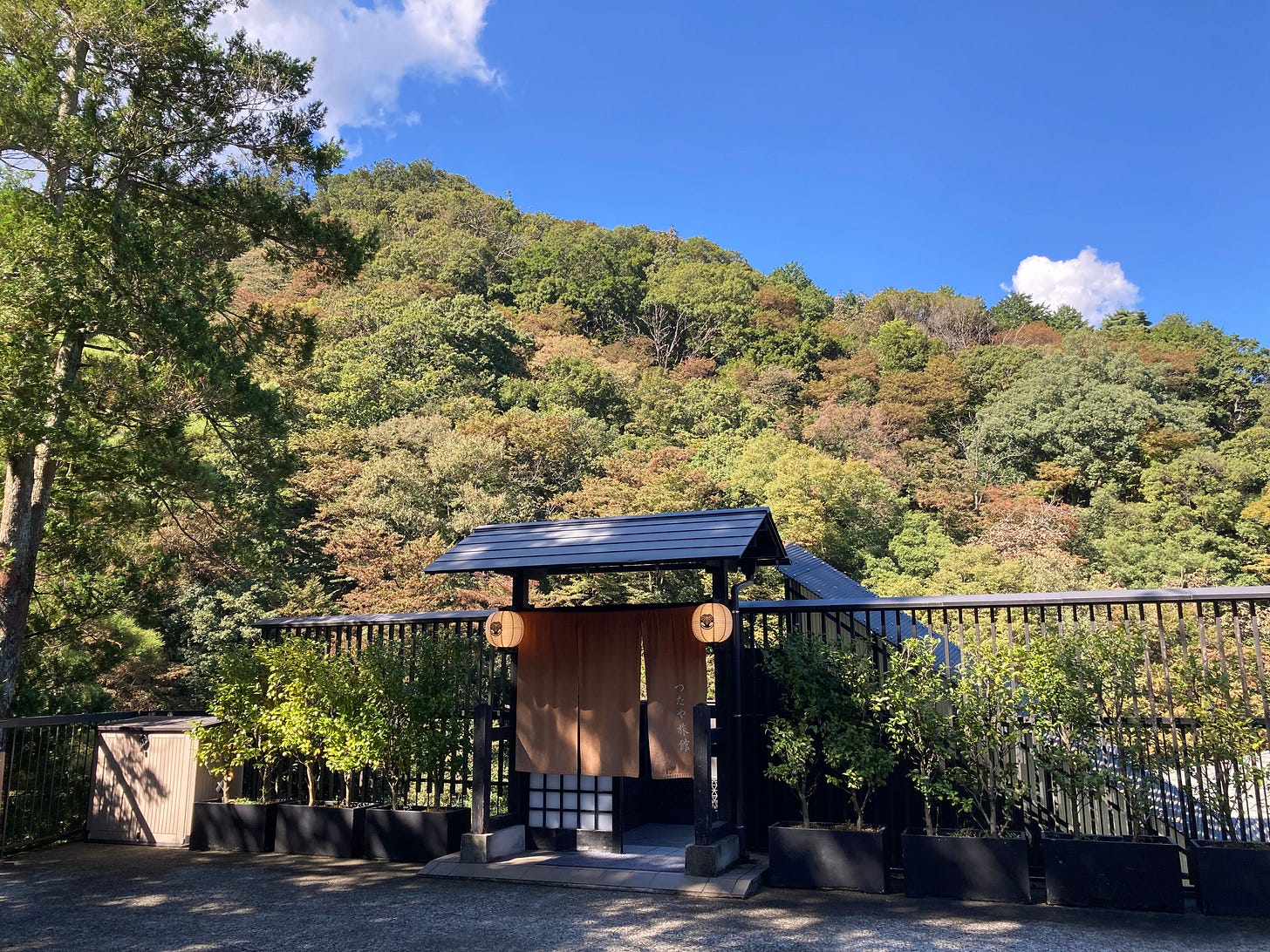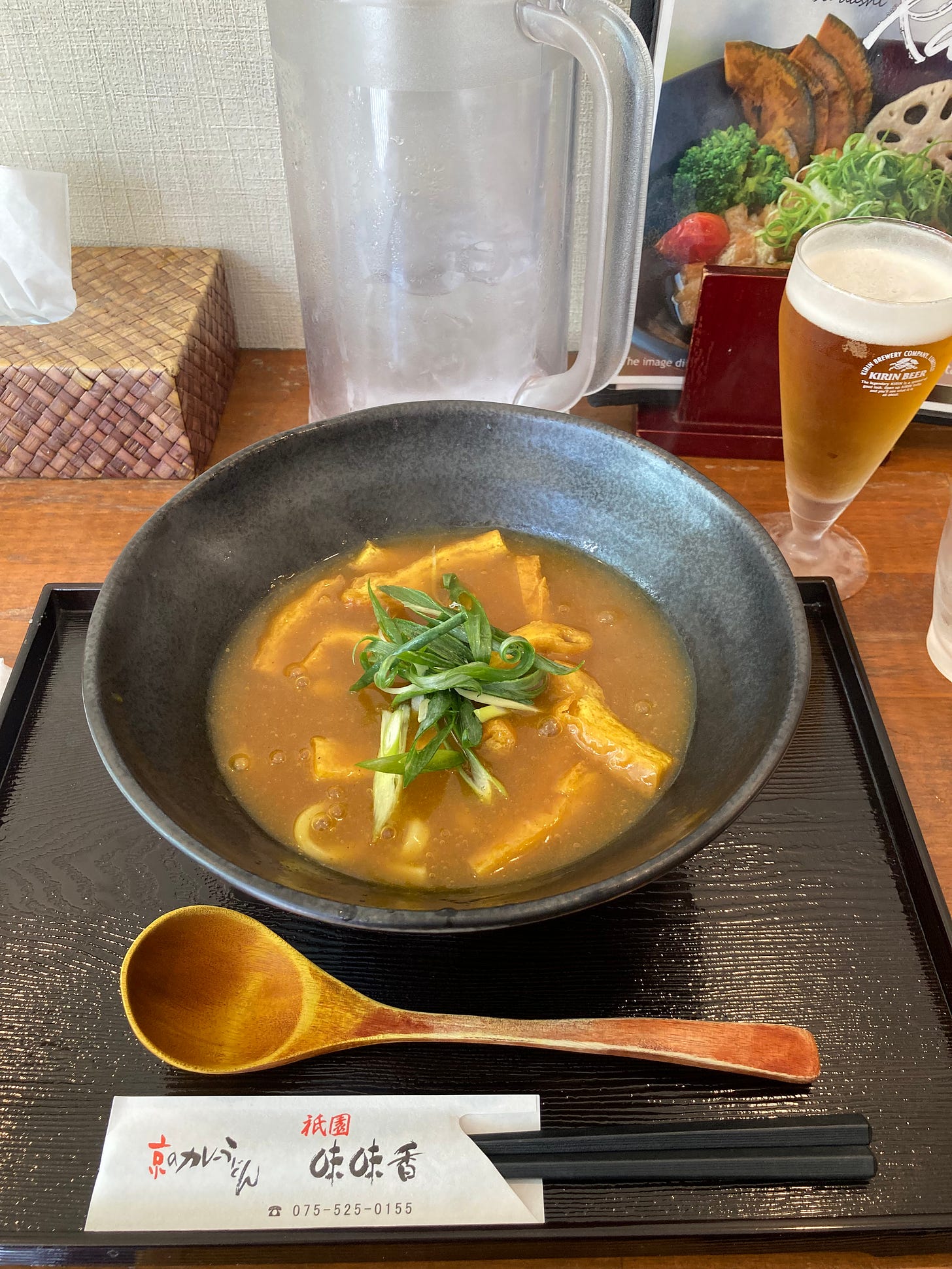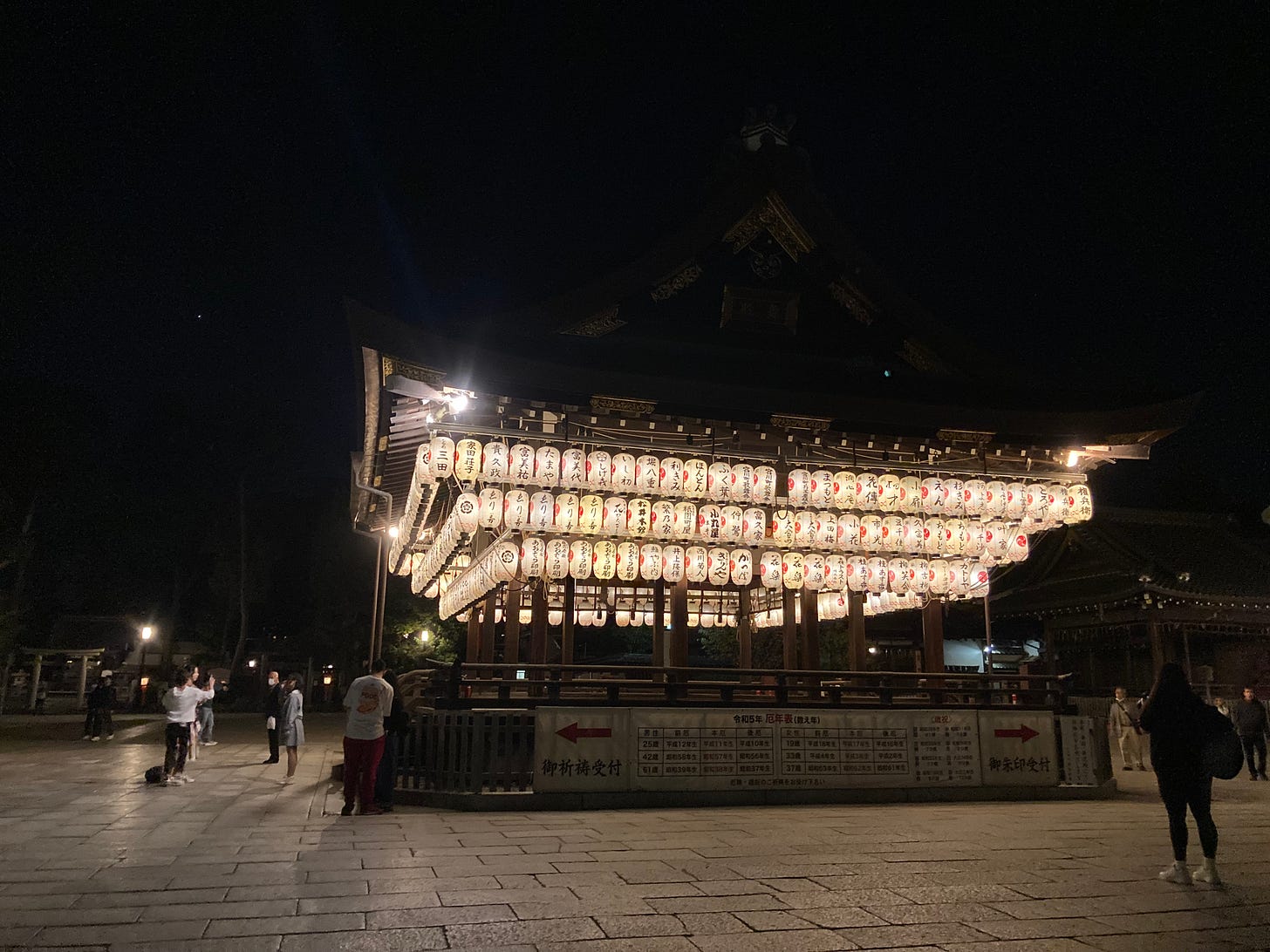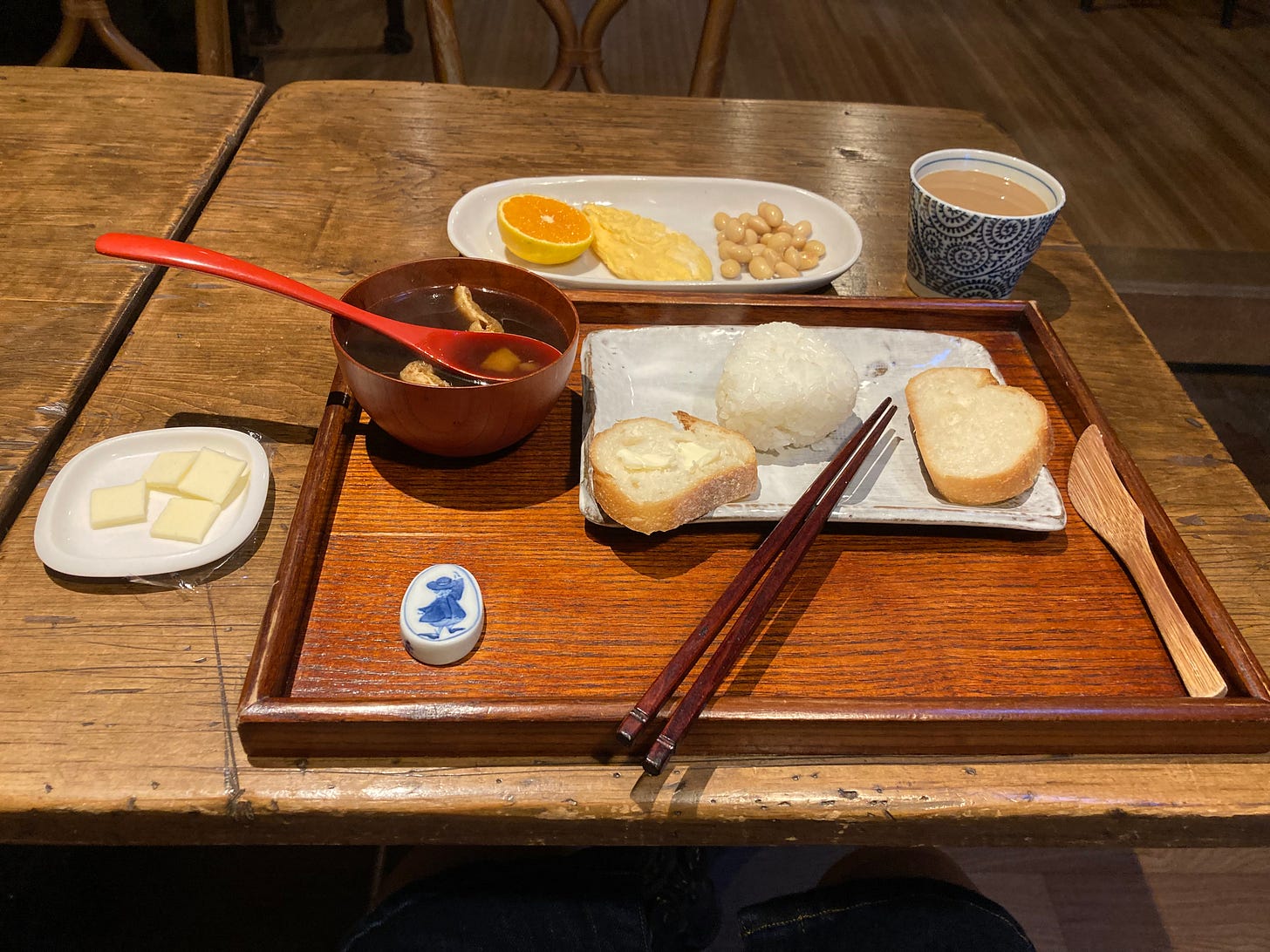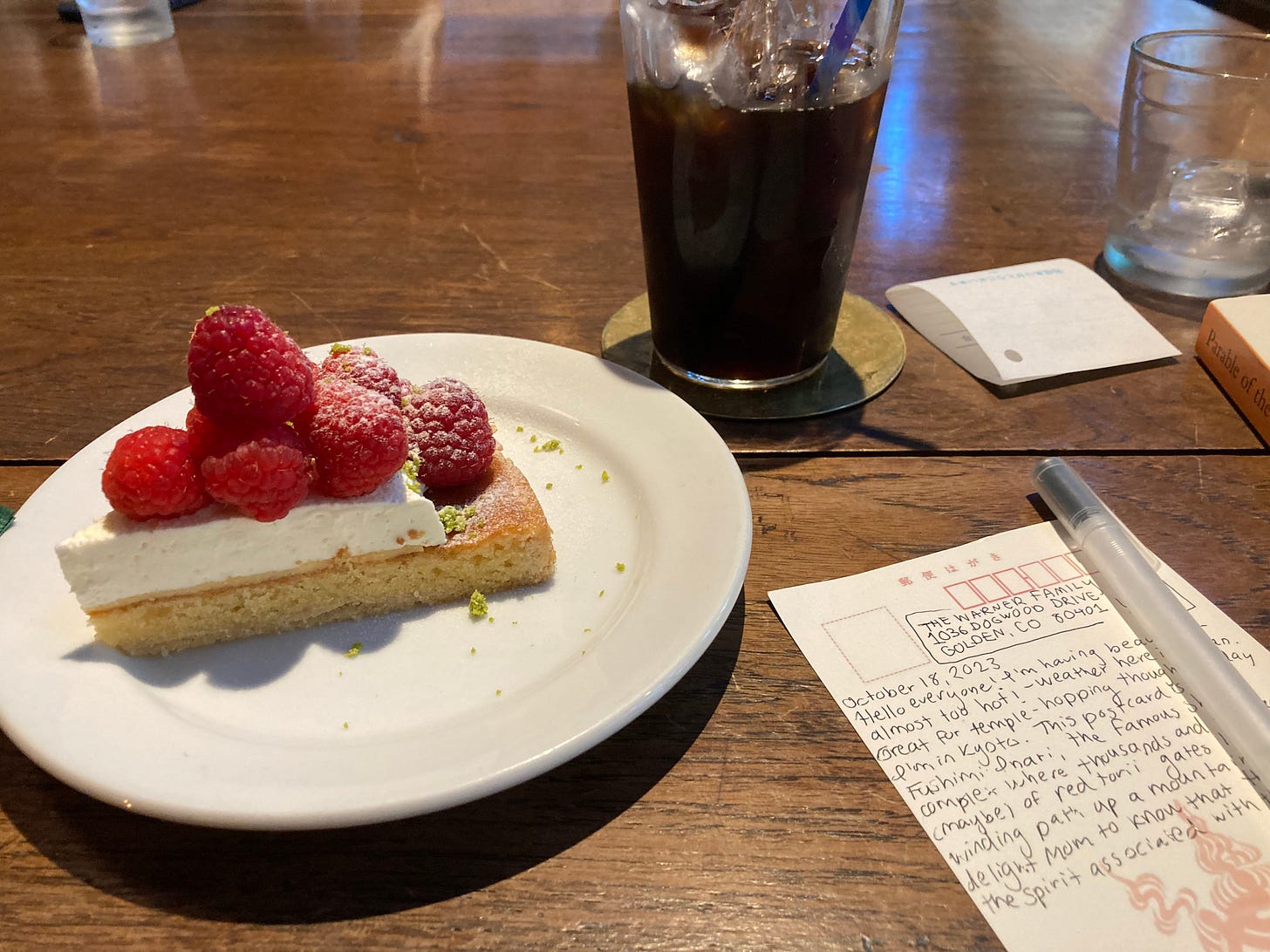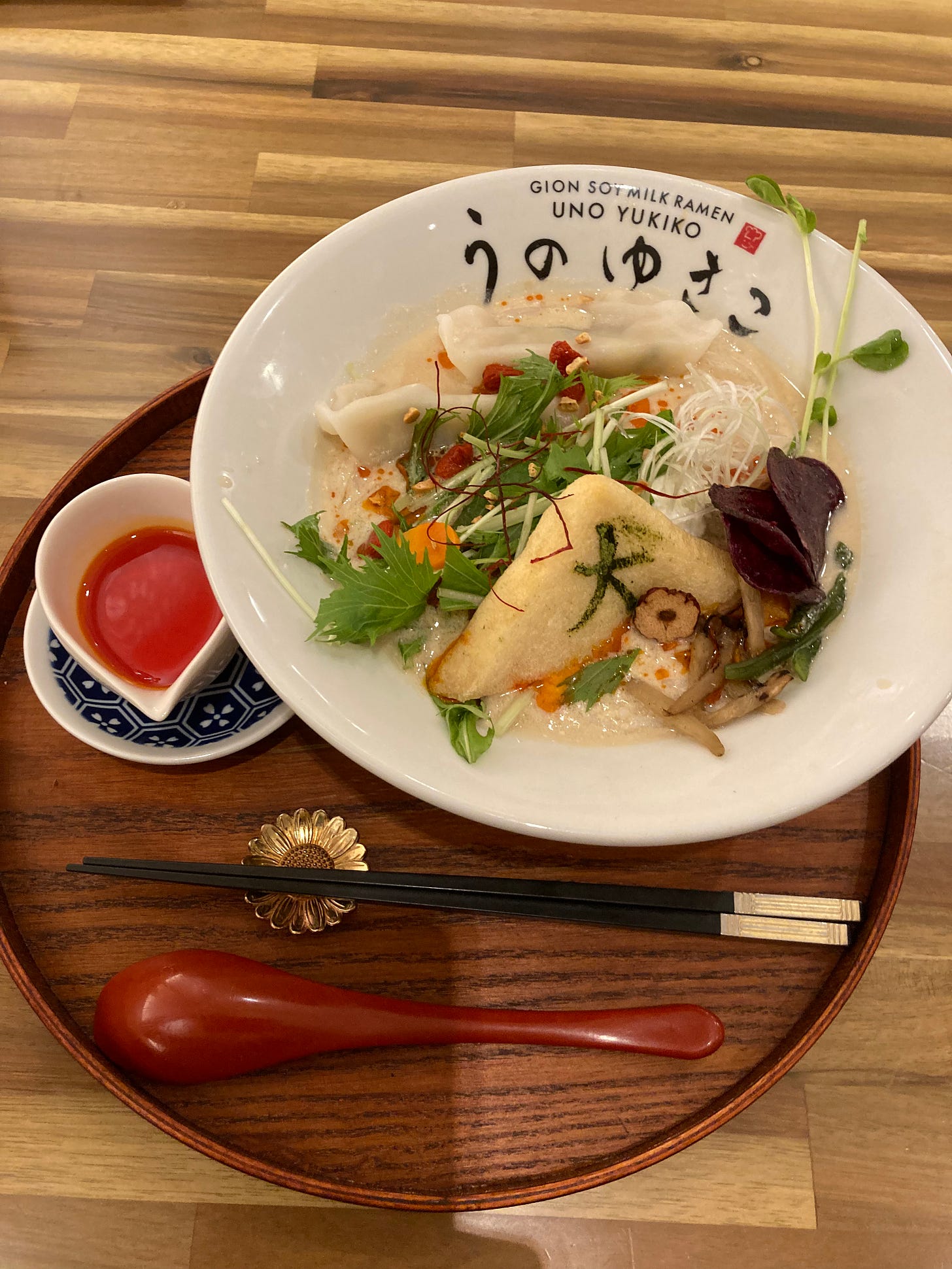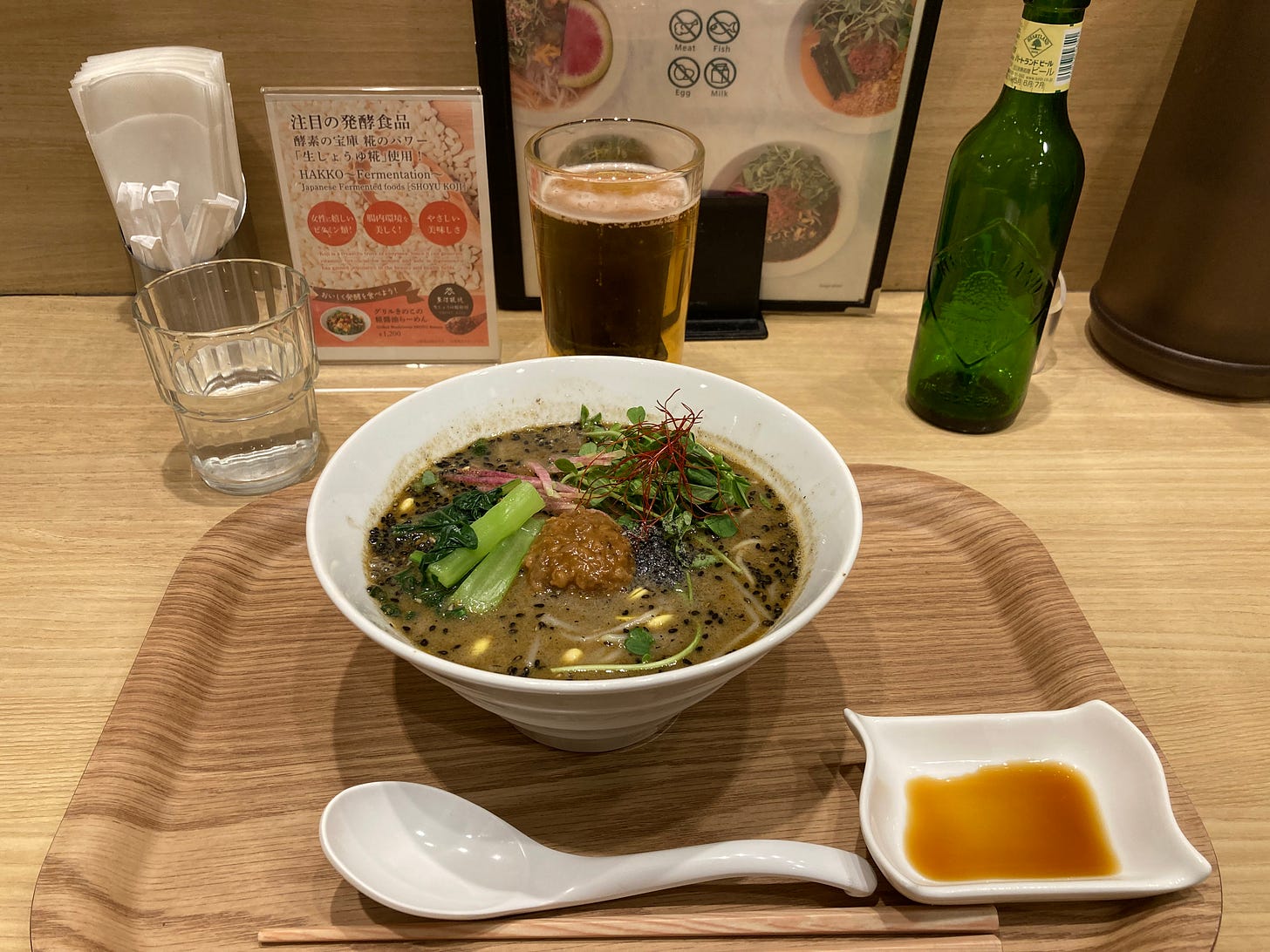Japan: The Grub Street Diet, Part 1
Kylie Warner believes Japan has an extremely underrated vegetarian food culture.She also accepts that it is time to switch to Substack.
Kylie Warner – a notoriously bad newsletter writer, barely known for the brand-new Substack called “Kylie Rated” – returned from Japan a few weeks ago. She felt enlivened and enriched by her trip but struggled with how to share the highlights with her friends and family. "The experience of going to Japan, three and a half years after I had originally planned, felt so intimate – sacred, somehow," she wrote in her journal. She later added: "Posting about it seemed liable to open the trip up to some of the baser instincts in our tourism culture: oohing and aahing over how to 'do' Japan properly, for instance. I wanted to have as much fun as possible, and to form my own conclusions about the country, without that white noise."
One area in which Kylie had received a lot of advice was around food. "As a vegetarian, people told me I was going to be in a state of perpetual agony or social awkwardness when it came to eating. Nothing could be further from the truth! Obviously, I had some rough days (as we all do when traveling to a new place!) but overall, I have to say that Japan has an extremely underrated vegetarian food culture that deserves to be explored and celebrated."
NOTE: TinyLetter announced last week that it is going out of business, hence this move to Substack. I’m rebranding once again – this time to “Kylie Rated” (get it?!) Thank you for your continued encouragement and readership!
Saturday, October 14th
I had heard such amazing things about Japan Airlines (JAL) for years – especially about the food. But, at least on my flight (from London to Tokyo), there were crimes being committed against vegetarians! I had reserved the lacto-ovo vegetarian meal, which ended up coming with a very bland creamy (?) pasta; a hunk of gluten-free bread with sunflower butter; and a tiny salad. There wasn't even a dessert! I guessed that they were giving the same sides to vegetarians, vegans, gluten-free, etc. and just replacing the main. I thought I could rectify the situation somewhat by claiming an ice cream when the flight attendant brought it around, but she took one look at my veggie meal tag and passed me by!
My first real meal in Japan was, unusually, Nepali food. I was staying at my friend Marie's apartment whenever I was in Tokyo. Her neighborhood is quite diverse, home to many South Asian and Korean immigrants. Because it was getting late the night I arrived, we decided to stick close to home; and, without having done prior research into the vegetarian food scene, we decided to go somewhere where there'd surely be veggie-friendly options. I had a warm dal and garlic naan, which is probably a go-to meal for me anywhere in the world after traveling. I paid without a clear sense of how expensive / cheap anything was, since the exchange rate wasn't fixed in my mind at that point. (The dollar is very strong against the yen right now; my average meal, with a main and a drink, fell between $10-13, I'd say.)
Sunday, October 15th
After hot chocolate and croissants for breakfast, Marie and I went into the southern part of Tokyo for a museum day – first at Tokyo Photographic Museum, then at Ota Memorial Museum for some ukiyo-e woodcuts on the theme of beautiful women in kimono.
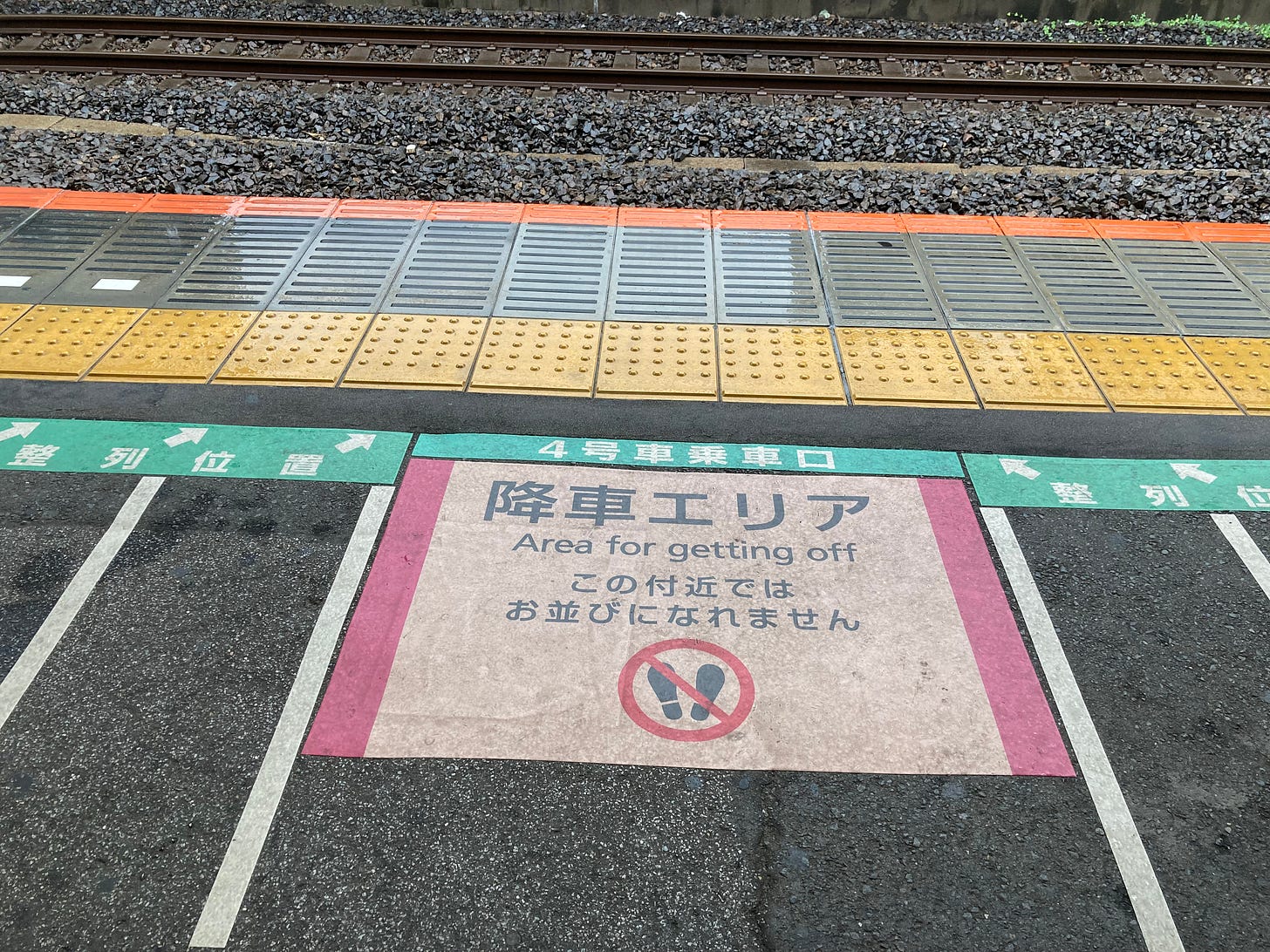
In between, we had lunch at Afuri, which I knew had a vegan ramen. It was my first time ever ordering at a machine, which I found delightful. I boldly decided to get both the vegan ramen – laden with bitter greens, carrots, radishes, and even tomato – along with a soy egg. I wondered if it would confuse anyone working in the kitchen, but as my trip went along I realized that most restaurants didn't seem totally aware of the distinction between vegetarian and vegan, for better or for worse. Usually for better!
We got a coffee in the afternoon to perk me up and settled on having dinner in Shibuya. Our first choice – Izakaya Masaka, whose name you will see again in part 2 – was a strike-out: even at 7pm, its waiting list was full for the rest of the evening. (We also struck out on going to Meiji Jingu that day, whose gates were closed right before our eyes. A good reminder to tourists to keep your itinerary expectations reasonable!)
Some quick thinking on Marie's part – and a reservation phone call – resulted in us going to Tofu Sorano, an elegant establishment dedicated to the art of tofu. (We killed time before our booking by checking out the stock and capabilities of the nearby 7/11.) There, we had tofu in all its guises: cold and freshly made, like a scoop of just-churned ice cream; creamy, tender yuba (tofu skin); and kaarage, fried tofu still prickling with oil. On the side we had potato salad (not as mayo-heavy as its American cousin), salty edamame, and a few delicate pieces of vegetable tempura.
Sorano is where I made my first compromise – to have the dipping sauces, dashi be damned. Dashi is the traditional stock of Japan, made with kombu (a type of seaweed), bonito (fish flakes), and sometimes other fishy creatures. It is possible to avoid it – and I did, most of the trip – but because I'm not allergic to fish / shellfish, I decided it wasn't worth the fuss to make an alternative arrangement at every juncture. Each tofu dish at Sorano had a soy sauce / dashi dipping accompaniment, and I tried all of them happily. My fatal flaw is that I love salty things.
Marie and I closed out the night by having drinks at Bar Legacy, a fancy cocktail bar in the basement of a car park (or so it seemed.) Craving coffee and bizarrely, dairy, I had a White Russian.
Monday, October 16th
I set out for my six-day solo trip to Kansai, though the first leg of my journey would take me to Hakone, the verdant mountain region just south of Tokyo, most famous for its onsens, or hot springs. To get there, I took a shinkansen ride for about 30 minutes to Odawara. Along the way, I saw Mt. Fuji, clear as day!
I had not gotten anything to eat for my journey, so I was quite hungry when I arrived at Odawara. I made my first konbini (convenience store) purchases – an egg onigiri and a seaweed one, along with a pre-fab iced coffee – and scarfed them while waiting for the bus that would take me deep into Hakone. I ate a lot of onigiri on this trip, and have to consider them my favorite konbini snack – so reliable! So transportable, too: I literally could put two of them into the front pockets of my jean dress! The ones at Odawara were probably the best of the entire trip, as they had the most veg-friendly selection there; everywhere else was very chicken / tuna / pork heavy.
After dropping my things off at my onsen, I explored the nearby Hakone Open-Air Art Museum, which was very cool; the scale and scope of its art, as well as the beautiful natural setting, reminded me of Storm King. I made a fatal tourist error, though: I did not make a meal plan, so by the third hour of exploring this lovely park on a lovely day, I felt like passing out. My options right outside the museum were limited: everything was closing, as it was nearly 3pm. I took a chance and walked 15 minutes into the nearest town, Gora, where, out of pure desperation, I went into the first nice-looking restaurant I could find – a traditional soba joint.
There, I had a veritable feast: cold soba with dipping sauce (as is my wont nowadays) and veggie tempura. Although the whole meal hit the spot, the sauce was definitely not veggie-friendly. At the time, I was too hungry to care, and even used the jug of hot water to dilute the sauce as a soup (as recommended by my server). I did feel mildly guilty about it though, later, for no specific reason beyond feeling that I broke my own "rules."
At the Gora train station I had my first soft-serve of the trip, in the classic, grassy "milk" flavor. I also shopped for dinner provisions at the extremely random gluten-free and vegan store nearby. I say "random" because this was literally a town of a few short streets, and with next-to-no veggie restaurants to speak of. And yet! Here was this store selling vegan donuts and other sweets, and dried ramen kits. (This happened to me more than once in Japan – the sudden evidence of a vibrant vegetarian food culture.) I bought a miso one to prepare later, and supplemented it with a pre-made soft-boiled egg (!) from a konbini, along with a bag of chips.
My hotel, Onsen Guesthouse Tsutaya, had a fully-stocked kitchen for patrons to use. After a soak in the outdoor onsen – naked, as per custom, and leaving me as refreshed as if I had gotten a long massage – I boiled my ramen and ate it in the tatami public space in my pajamas. I slept the night in what was effectively a wooden pod, in a hostel room with seven other women. Everyone needs a low-key day / night like this on their vacation, all the better when jetlagged.
Tuesday, October 17th
After another trip to the onsen, there was no real breakfast for me this morning: I had to get an early start to catch the shinkansen back in Odawara, and besides, there wasn't much open on my very rural road in Hakone. On the bus ride back to town I made friends with an elderly Japanese woman. We'd both cluck our tongues whenever tourists tried to board the bus without a proper ticket, and she pointed out local sights (e.g. the supermarket) to me. When we reached the station, we bowed to each other and waved happily goodbye from the escalator. Definitely a top interaction of the trip.
With the same onigiri as yesterday in hand, I boarded the train for Kyoto. Upon arrival, I was better prepared for lunchtime: I had marked a curry udon place, called Mimikou, that was close to my accommodation. As a rule, curry udon isn't very interesting to me: something about Japanese curry's mild and smooth character gets lost when it is turned into broth. But Mimikou had an explicitly vegetarian menu, which was exciting. I got a kitsune curry udon – kitsune being a preparation style for many noodles involving a bit of spring onion and long strips of thin, sweet tofu. I was so hungry that I consumed the bowl (and a beer – lots of cheap beer was consumed on this trip!) quickly, burning my tongue. I still found the curry to be more bitter in this form than I would have liked, but it was absolutely the sustenance I needed to climb up through Marayama Park with all my luggage.
After dropping off my things at Yoshimizu Inn – a charming ryokan, or traditional Japanese inn – I ventured through the closest temple, Chion-In, and shrine, Yasaka Shrine. I walked through both multiple times over my days in Kyoto, and they never lost their appeal. Chion-In has a massive gate to welcome or see you out; Yasaka, all orange and vermillion, is always abustle with people praying or buying omikuji (fortunes), even at night. (It was a literal beacon to me each evening when I would return home, through the very dark park – which, being the city girl that I am, felt dangerous and provocative, despite Japan being a very safe country.) Since it was still afternoon, I was able to get a matcha soft-serve from the park cafe – lovely texture, and, as expected, not too sweet.
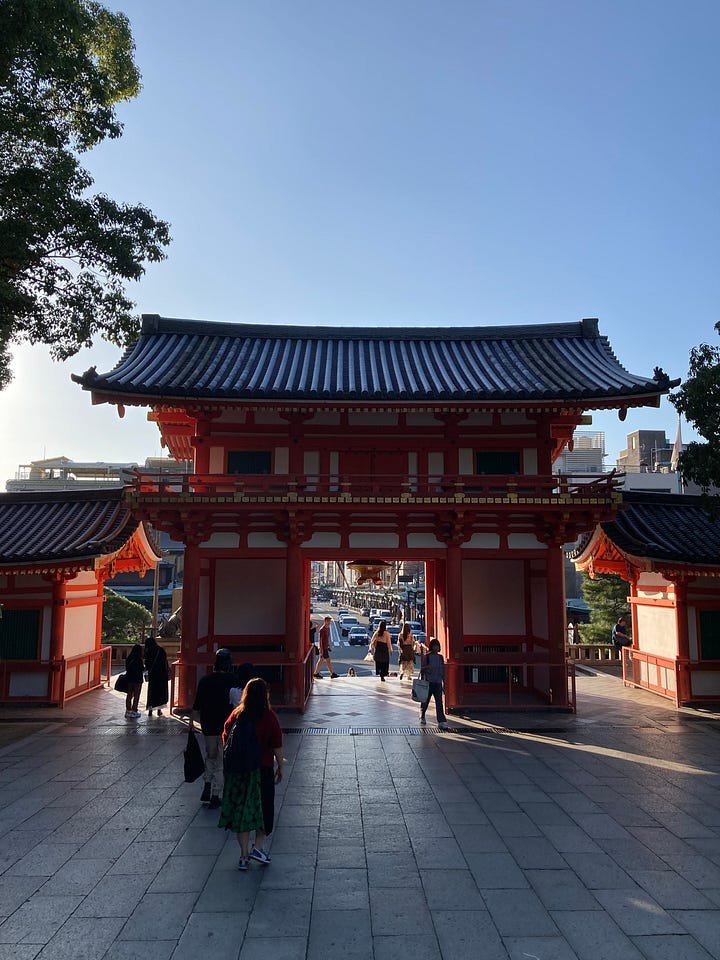
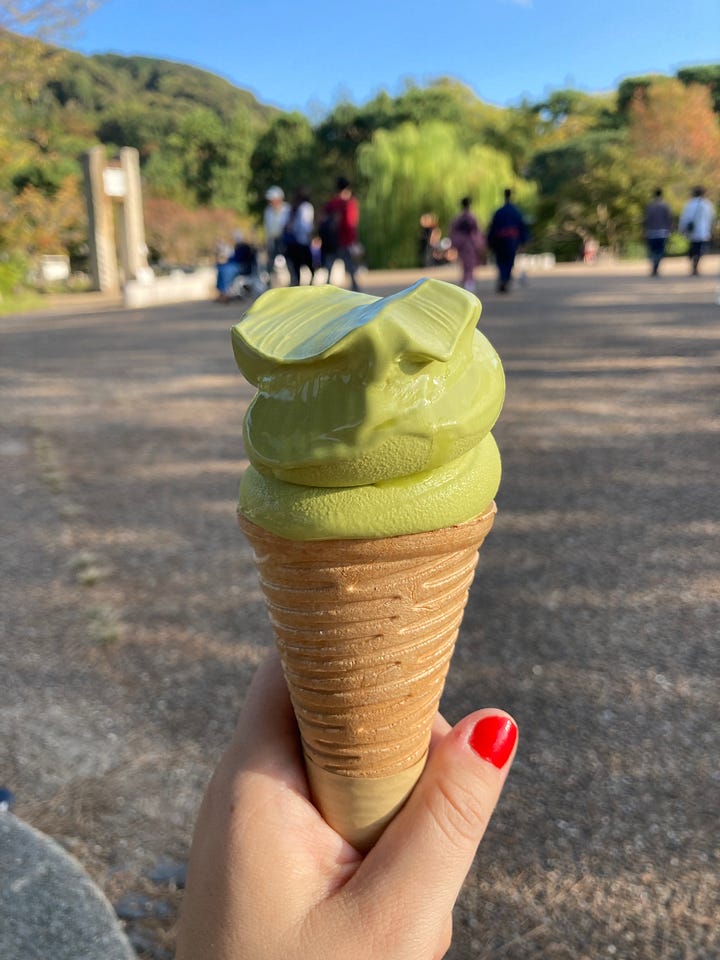

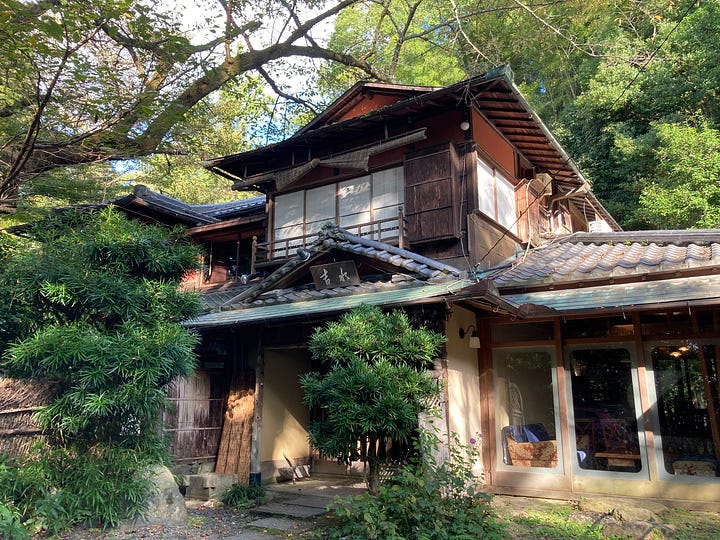
After some shopping in Kyoto – for cosmetics, tabi socks, and a beautiful kimono-modeled wool sweater – I sat for an early dinner at Nijiya, a vegan izakaya. When I call it a "hole in the wall," I really mean it: the three workers would slip in and out of the tiny kitchen to serve patrons outside using an almost doggy-door like opening in the outer wall. The establishment only seated six indoors, right up against the border of the kitchen – a real izakaya experience. I had the three-course obanzai, or a feast of small plates made with simple ingredients local to the area: soy sauce slicked leeks, a gorgeous square of fried tofu heaped with scallions, and some sort of crunchy cracker (?) served alongside blackened shishito peppers. I also ordered
vegetable gyoza, ochazuke (slightly dry brown rice that you submerge in hot green tea), and yakitori, which was surprisingly my favorite dish of the night. I'm not usually that keen on fake meat, but something about the succulent preparation – coated in salt and grilled over high heat – appealed to me, especially after my initial days of intense walking. All this was washed down, of course, with a yuzu highball.
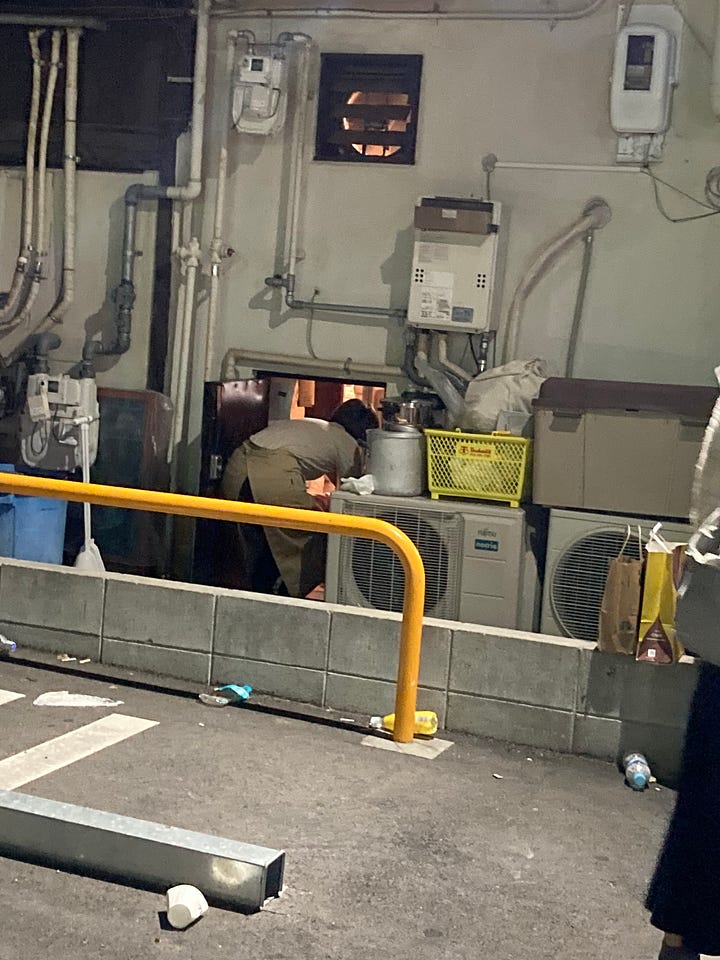
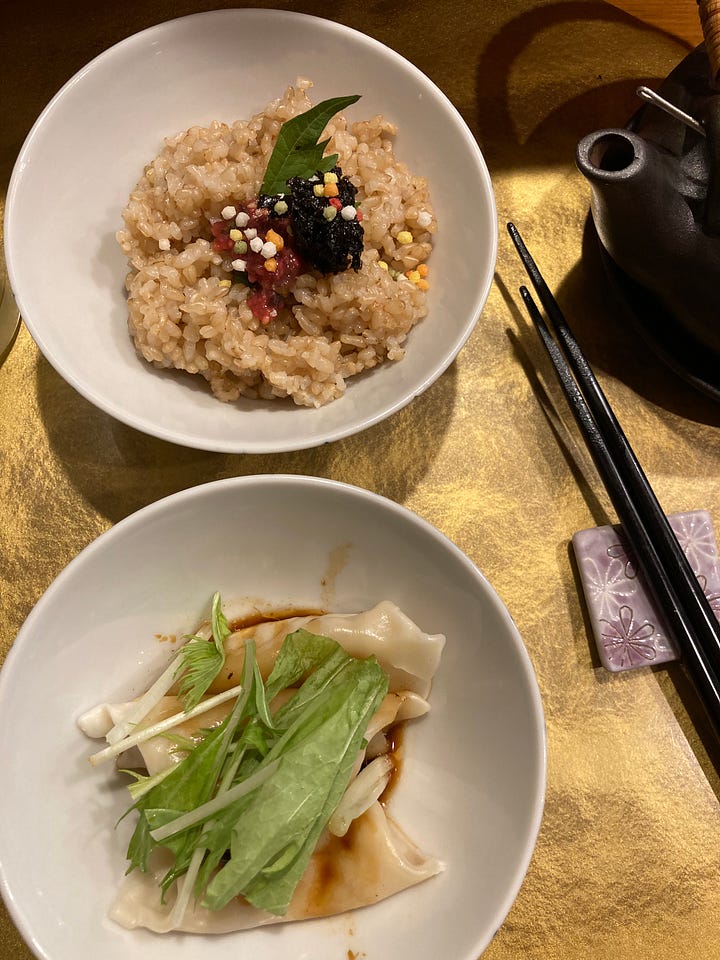
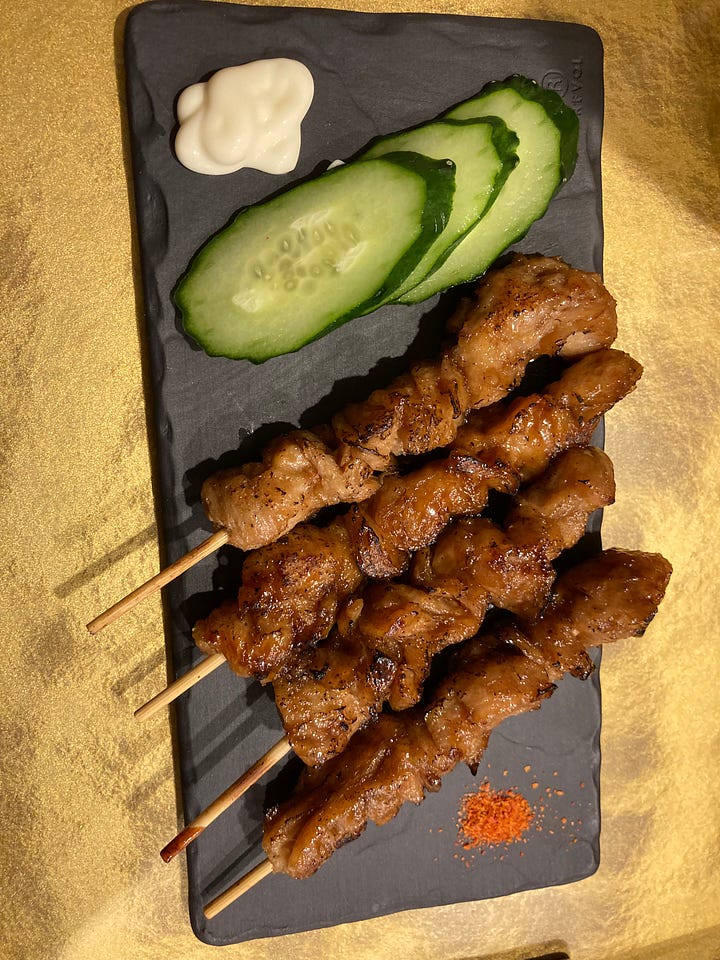
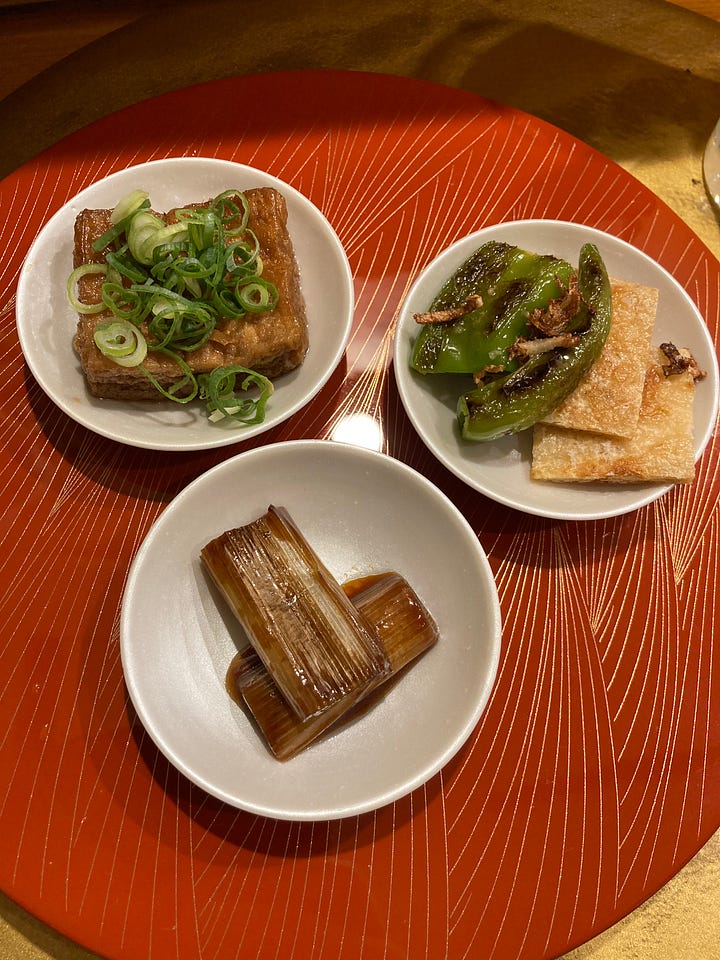
The streets of Kyoto are extremely atmospheric at night. I wandered through Pontocho, a historic geisha street filled with tiny restaurants, all kept relatively private by paper sliding doors and abundant foliage. It was one of the rare moments on this leg of the trip where I wished I was with someone, so we could peek inside one of the establishments together. Unfortunately, the street was also filled with tourists – including a few I recognized from my onsen / travels thus far – and so I began winding my way back home.
One pitstop: at a traditional sweets shop, to buy my colleagues a gift. I settled on some very thin, elegant cookies in sugar and matcha flavors. The shop attendant tried to get me interested in black bean tea and black bean jellies, and though they were more delicious than I expected, I knew that my colleagues would not approve. (In fact, they barely even approved of matcha-flavored sweets, as I found out upon my return!)
Staying in a ryokan is probably not for everyone, but I enjoyed it immensely. I loved sleeping on the floor on a thin futon; bathing sitting down on a wooden stool in communal washing area; the low light and simple furnishings of the establishment. But it was quite cold (I was on the ground floor), and I think I made myself sick by turning on the heat in my room. For the next few days, I was burdened by some sort of cold / allergy attack that had me using all the tissues at the inn.
Wednesday, October 18th
The next morning, the very nice woman proprietor of Yoshimizu made me and the other guests breakfast. It was simple and mostly Japanese-style: miso soup, rice balls, some soybeans and fruit. There was also bread available, with the thinnest slices of butter to smear on; and scrambled eggs, made to order. I watched in humor / horror as an American family launched a hundred questions at the woman about how to get to Fushimi Inari Shrine, despite the fact that 1) she didn't speak any English and 2) it was a relatively straightforward route.
In fact, I was going there myself. This shrine complex, in the south of the city, is famous for its hundreds of vermillion gates, lined up like dominos along a lush mountain. You start your journey at the base, in the main shrine complex, which is buzzing with activity no matter the hour. Pretty quickly, the gates begin to present themselves, layered tightly together, like an accordion or cherry-stained puff pastry. I didn't have to walk very far before I was alone enough to have some pictures taken by an American couple, though the crowds did wax and wane as I ascended. Every few minutes, I would come upon another mini-complex selling adorable fox-themed merchandise, representing the main shrine spirit.
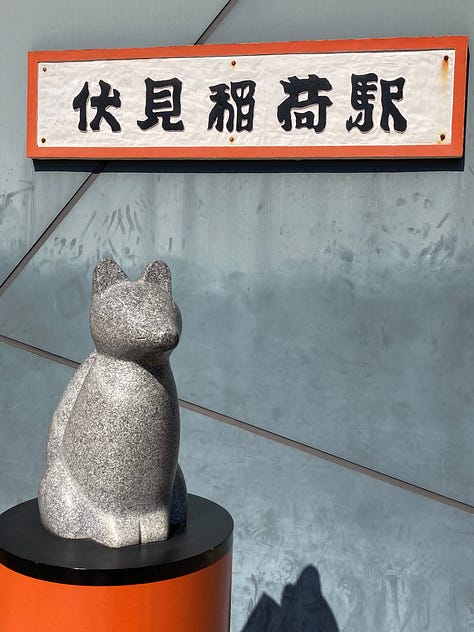
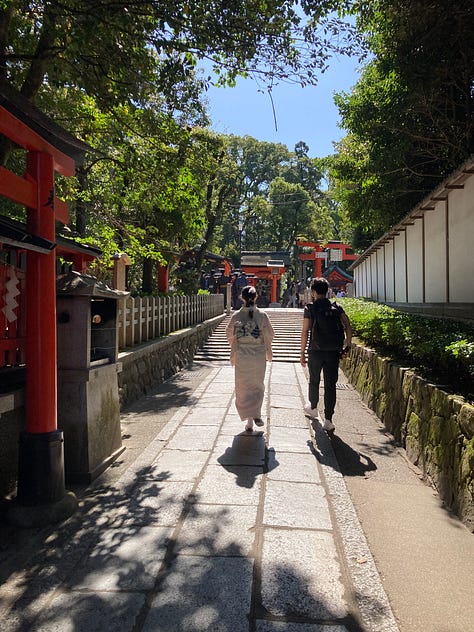
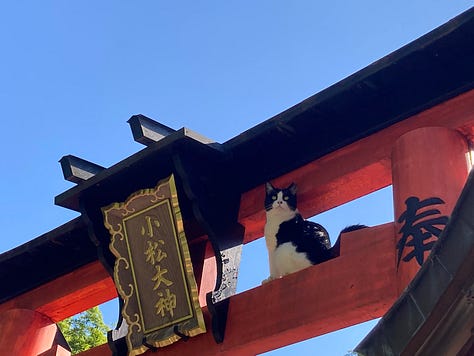
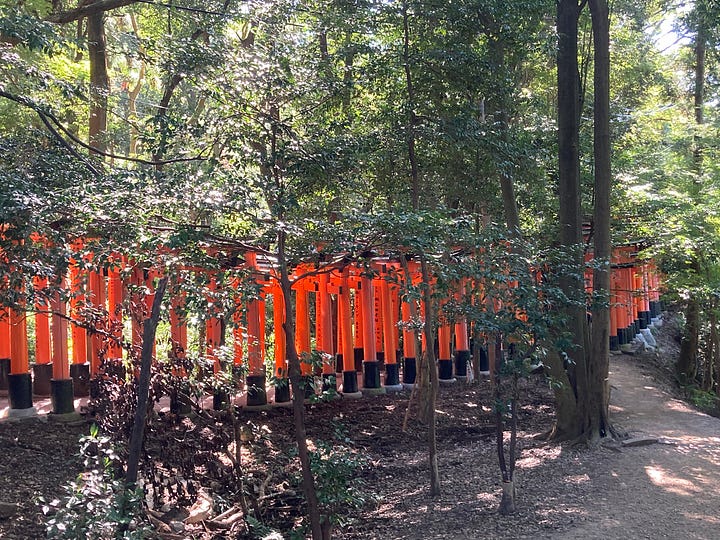
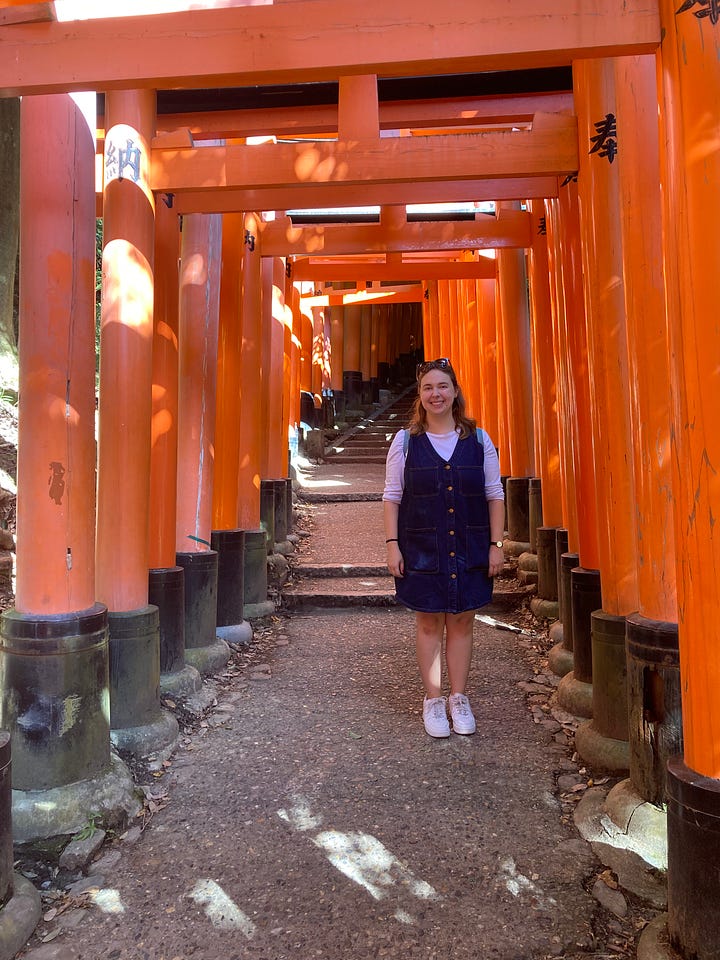
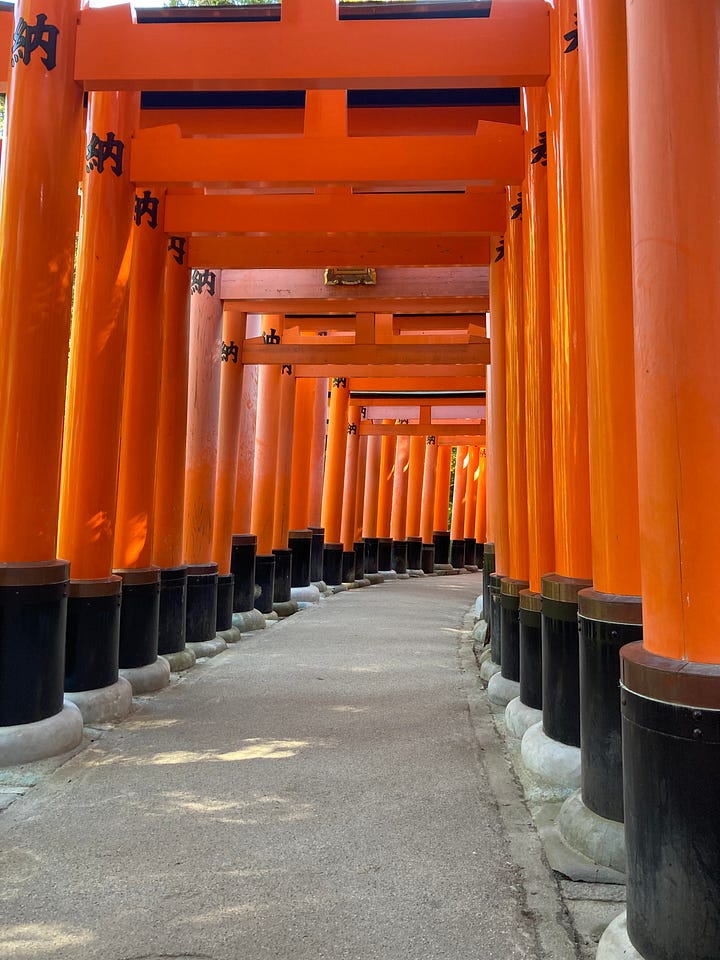
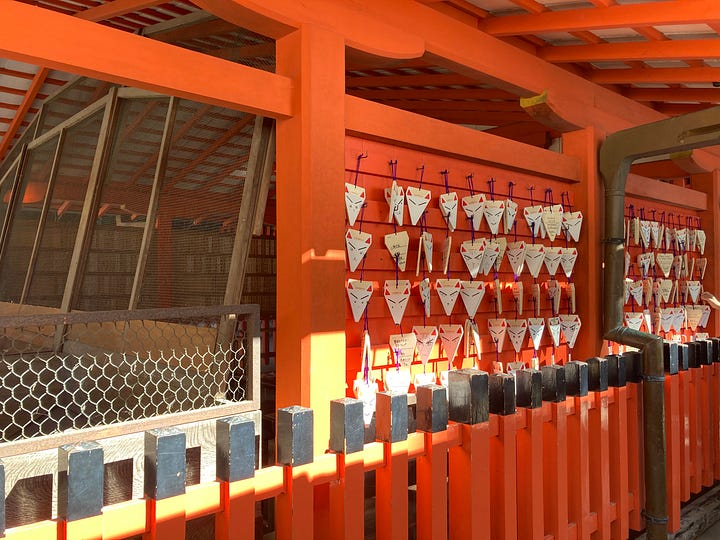
Although it was tempting to do the full loop of the shrine by climbing to the top of the mountain, the temperatures were almost summer-like. So, once I had caught a panoramic view of Kyoto, I started back down, seeing some animal friends along the way. At the bottom of the mountain, near the main shrine complex, I had an iced matcha – my only matcha of my entire time in Kyoto! – and a cookie at Vermillion Cafe, which hosted an even split of Japanese locals and Australian tourists. (And the random American, of course!)
Once again, I made the fatal tourist error: no lunch plans! This time though, it was on purpose. I realized within hours of arriving in Kyoto that I loved the city and would struggle to see as much as I wanted within my few days there. So lunch became an onigiri picked up from a 7/11, and, a few hours later, a literal slab of freshly fried tofu. (I had been under the impression it was a street food, but I had to sit down on a bench among a bunch of eager school children also partaking in fried food to eat it successfully.) In the middle, I went to Kiyomizu-dera, a truly fantastic temple spilling down yet another verdant hillside. I loved walking along the ridge for views of the main temple and Kyoto at large, and into the serene surroundings of the Easy Childbirth Pagoda. (This was briefly mentioned in "The Makioka Sisters," which I reread while in Japan – more on that later!)
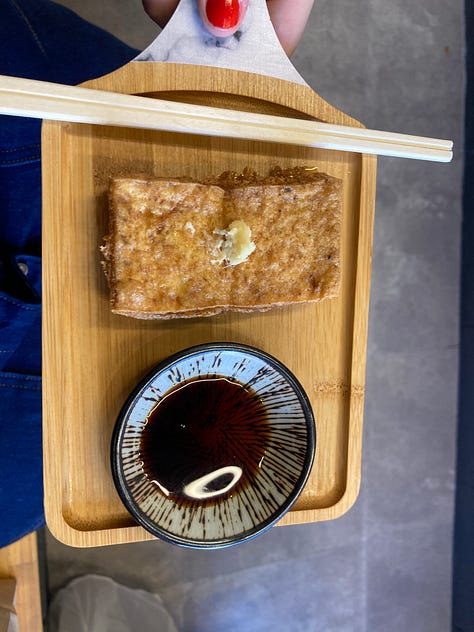
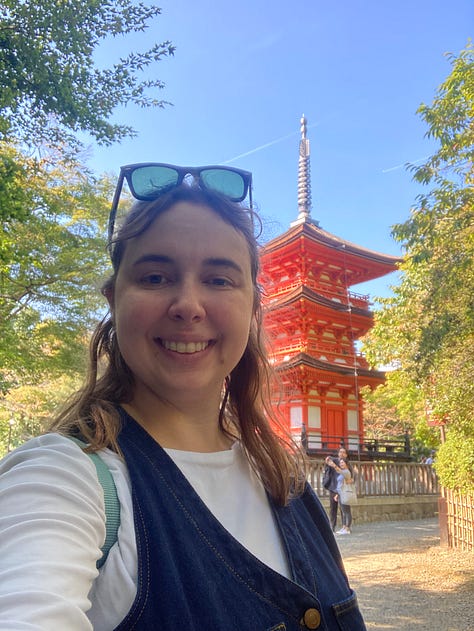
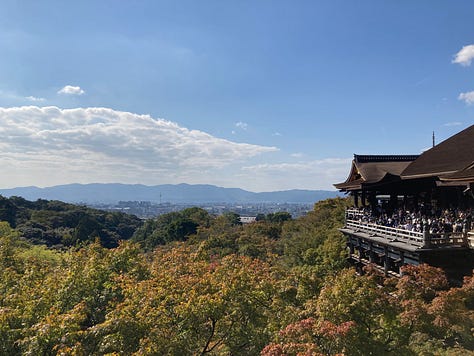
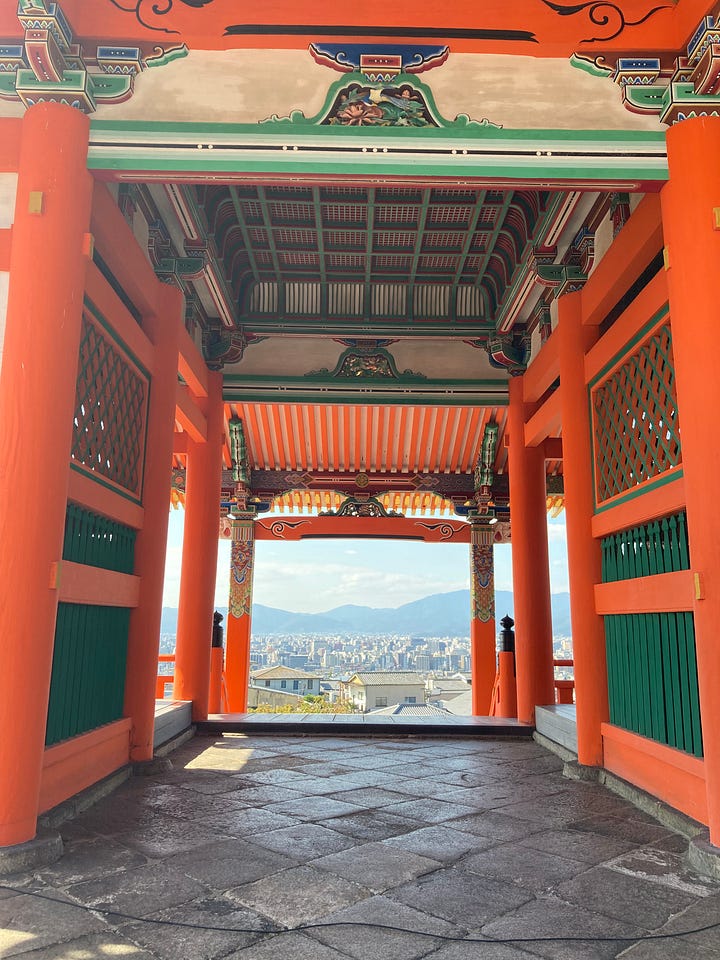

Yet sadly, the crowds and the heat became a bit much for me, so, after some brief pottery shopping, I descended through the cute, historic Ninenzaka area back into the city center – and decided to do some more shopping on the other side of town. I ended up in a neighborhood that was a bit more upscale, a bit more residential, and the streets were free of tourists. Leisurely, I explored the area, had some wholesome interactions with the Muku and Ippodo shop workers, and filled my bags with matcha and lacquer trays, black as velvet.
Naturally, though, hunger began to strike, so I retreated to Cafe Bibliotic Hello! (name includes the exclamation mark!) for some cake and coffee. It was a lovely, greenery-filled space, though lined with records instead of books. The vibe was impeccable: Japanese people of all ages sat around me, reading books or talking amongst themselves. (It cannot be understated how friendly Japan is to solo travelers / loafers.) I also thought the cafe had a clever approach to cake preparation: they basically sold a very simple, light cheesecake – more crust than cheese – adorned with seasonal fruit of your choice. I chose raspberries, and the overall effect melted in the mouth.
I could only take about two hours of reading "Parable of the Sower" – my book club's choice for October – before becoming extremely paranoid, so before it got properly dark I went searching for dinner downtown. It's interesting, given Japan's notorious demographic plight, how many young people are about in a hybrid business / residential district such as this: returning from work, carting their babies and toddlers around on the backs of bikes. Visually speaking, it's almost impossible to perceive that this is an especially old nation.
I wasted a good half hour searching about for a specific tofu restaurant that I had neglected to make reservations for; I suspect now that it was one of those subtly marked, almost secretive establishments buried at the bottom of a side street. In general, I wish I had been a bit more proactive about securing reservations when necessary, but also, being a solo traveler for this leg of the trip, I wasn't exactly looking to dine at the more "experiential" places – next time with company, I'm sure.
I ended up eating in Gion, another traditional geisha district, at Uno Yukiko, which sold soy milk ramen. Not only was it vegan, but it was also gluten-free! This was a common pairing in Japan, I noticed; and though I didn't mind taste-wise, it made me reflect on the expected clientele of such restaurants. Uno Yukiko was entirely filled with foreigners – not unusual for establishments that catered to people with dietary restrictions. But Kyoto is particularly well-known for its shojin ryori – a type of vegetarian / vegan cooking most associated with Buddhist monks. It’s very well-respected within Japan, and Uno Yukiko nominally followed all the tenets of shojin ryori, down to the exclusion of “pungent vegetables” (garlic, onions, etc.) from its food. As I ate my ramen – overloaded with vegetables, dumplings, and a spicy oil that was accompanied by menu commentary saying that “even women could eat it!” – I wondered whether Japanese people often ate here, or whether the foreign tourists, in spite of their restrictions, would be open to eating at more traditional Japanese restaurants, even if their options would be more limited. That wasn't to say that the ramen at Uno Yukiko wasn't "authentic" or delicious: soy-milk ramen isn't uncommon in Japan, and the one at Uno Yukiko was well-balanced. But there was something that perturbed me about the menu’s emphasis on dozens of vegetables as being “healthy,” the addition of dumplings to the noodles, the absence of any protein (like tofu). I suppose I was keenly aware that my Westernized taste buds were being considered in a more obvious way than usual.
Walking back home through Gion was lovely – I even saw a maiko, or apprentice geisha, scurrying through the streets! I bought a beer at a konbini before trekking back for another quiet evening of reading and planning for the next day in my room.
Thursday, October 19th
Once again, breakfast was served by my kind hostess – a similar spread to the day before, but this time with some lightly stir-fried peppers and potatoes to go alongside. I was well-fueled for my most difficult day of tourism yet: trekking out to the northwestern hills of Kyoto to visit Kinkaku-ji, or the golden temple. Being dropped off by bus a few minutes’ walk away from the temple gave me a more realistic view of its environs: a hot, somewhat dusty, quiet neighbourhood. The buzz of the tourists and the infinite number of schoolchildren and the spurts of tour buses attract you towards the temple complex, almost despite yourself. It was still relatively early in the day, but it made no difference: the complex was a zoo, and after 20 minutes of weaving my way through crowds, and of lifting my phone high so that I could capture the shimmering effect of the water waving beneath the gold leaf, I had had enough. Restoration came through a matcha soft serve – this one gussied up with matcha powder and gold leaf. (A group of older Australians were fascinated by my love of matcha, and erroneously thought I had a massive sweet tooth as a result.)

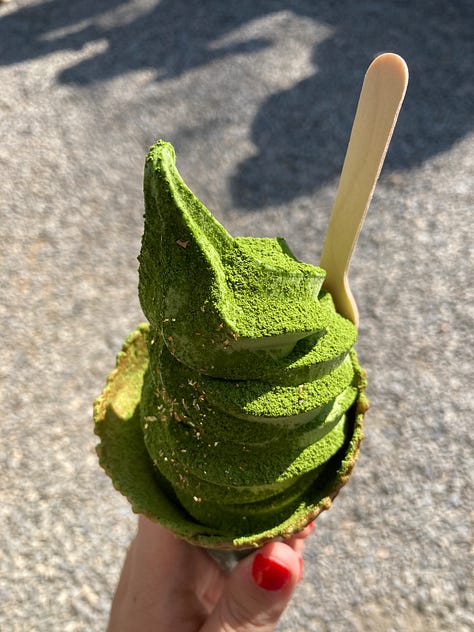
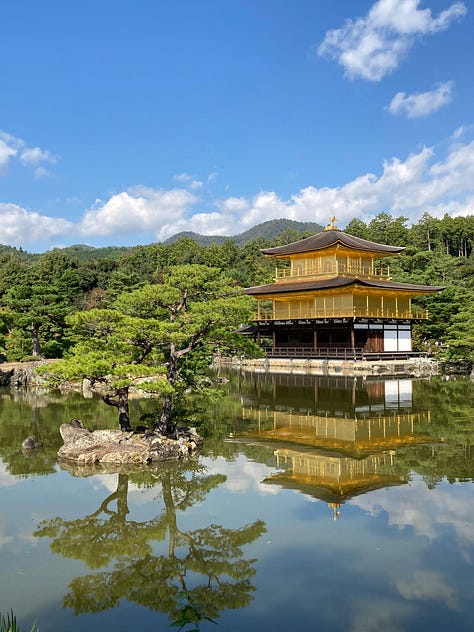
Further sustenance was required, though; and because there weren't too many restaurants around Kinkaku-ji, I decided to have an early lunch at Gontaro, a soba and udon shop. It was my most traditional dining experience of the trip thus far: I took off my shoes in order to sit at a low table on the tatami, and two servers wearing kimonos fluttered about, minding me and the other customers (a salaryman and a group of schoolboys) and the garden outside. Although I had done some research the night before about Gontaro's options for vegetarians, I retained some anxiety: it wasn't immediately clear from the printed menu what was truly vegetarian and what was merely vegetable-led. But, again, I went with the flow, and ordered the giant lunch set, comprised of udon in a simple (vegetable?) broth; veggie tempura; some silky, almost smoky tofu; and a sort of fried rice dish. It was all very solid, filling food, and the atmosphere of the place – the chatter of the boys especially – made for a delightful backdrop.
Gontaro had re-energised me to the point of madness. I next went to Ryoan-ji, a truly serene temple most famous for its Zen rock garden. The other, more verdant gardens and the lake surrounding it were also divine: a welcome and shady respite from Kinkakju's activity. Admittedly, though, I was starting to become a little temple-d out – I guess you could say I was craving some secularity – and so I boldly made Nijo-jo, a castle across town, my final sightseeing destination of the day. I really enjoyed encountering this side of Kyoto's history. The castle is not dissimilar from a temple, with its manicured, expansive gardens and endless maze of interiors within a wooden building. And yet the past was much easier to imagine playing out across this place, where the Tokugawa Shogunate – perhaps the most powerful in Japan's history – was both established and ended. The historical information on the walls certainly helped my imagination, but I was mainly enticed by the immediacy of the aesthetics: the creaking floorboards, said to resemble the songs of nightingales, and the gold panels of the rooms, adorned with scenes from nature, ranging from the graceful (plum trees) to the obscene (the faces of tigers, painted by artists who had based their work on that of other artists…..who too had never seen a real tiger.)

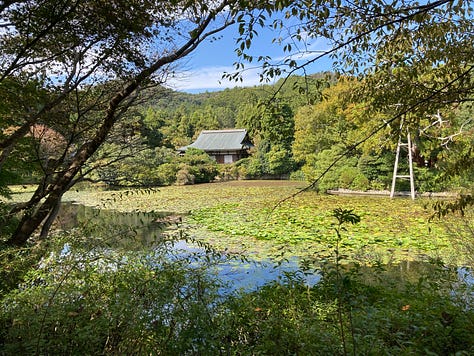

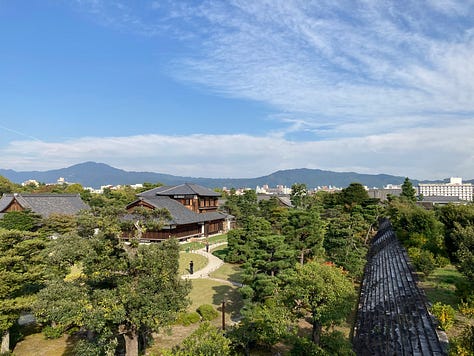
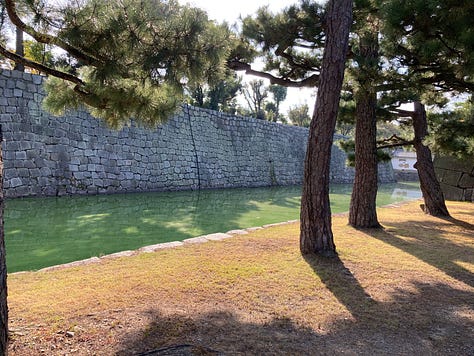
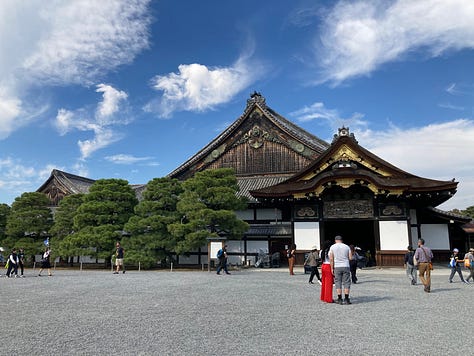
Naturally, the true secular pursuit – shopping – beckoned. I went to a new-to-me district of Kyoto, where all the cool shops for the cool kids were; I had a coffee alongside some of them at a cafe that was literally at the back of a parking lot. This was spontaneously supplemented with a baked potato from a cornerside stand. because I got the "vegetarian," it was loaded with vegetables rather than anything decadent, but I was able to add as much ketchup, mayo, and – blissfully! – hot sauce as I liked.
In an experience not unlike choosing a wand from Ollivander’s, I bought a beautiful folding fan in a gentle, bashful pink from a historic shop. Unfortunately, my mysterious illness was catching up with me, so I gravitated once again to an early meal, this time at Kyoto Engine Ramen, which I had found by chance a few days earlier. Like Uno Yukiko, this was a ramen establishment primarily of interest to foreigners, who had filled it to the gills even at 5:30pm. (As usual, though, in this solo-diner-friendly country, I was seated quickly.) I preferred Kyoto Engine's ramen overall. Although also soy-milk based, it took on spice much more powerfully than the ramen I had at Uno Yukiko's, and it was more subtly decorated with veggies: just a sea of floating scallions and thin slices of onion or radish. This preparation seemed to allow for plant-based eaters to do away with the facade of wanting something "healthy," and to simply indulge in beautifully made, pleasantly unctuous broth.
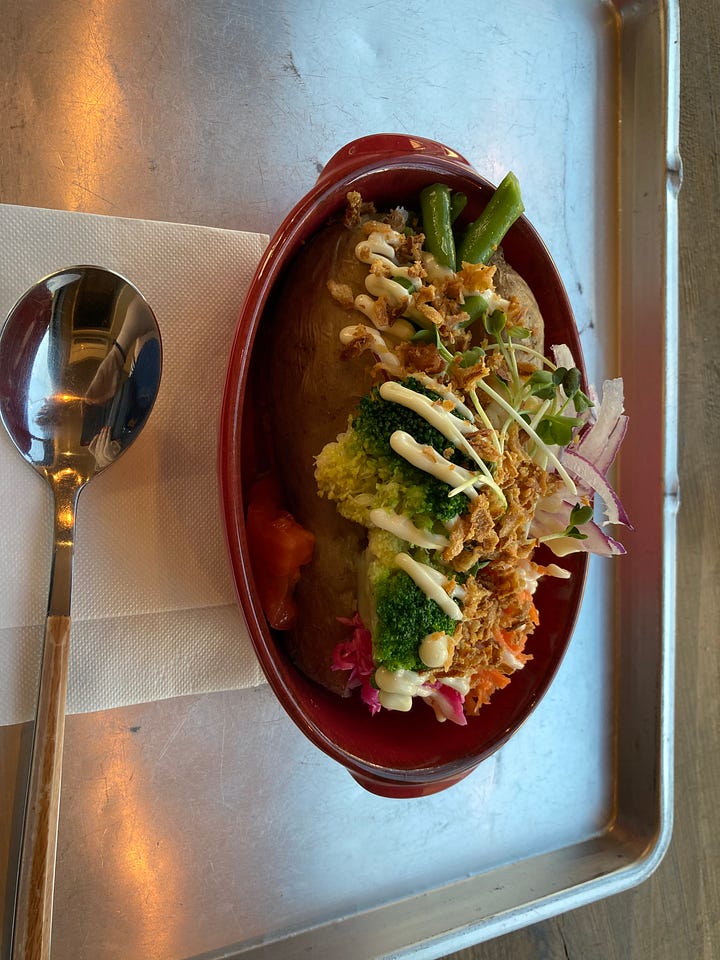
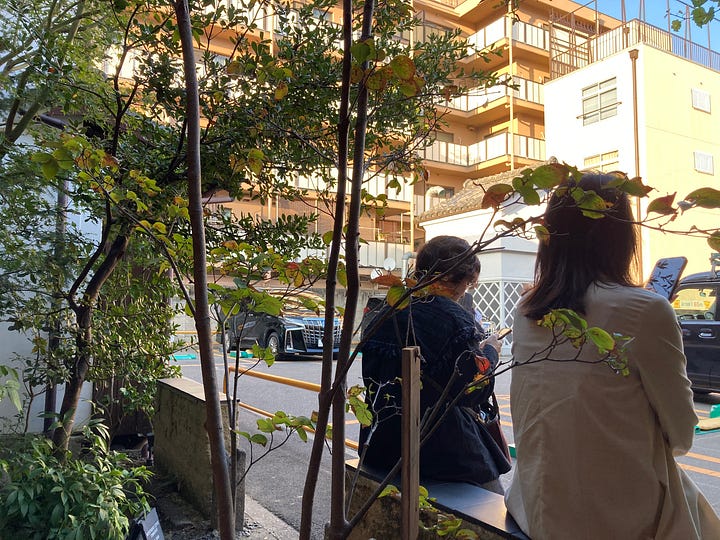
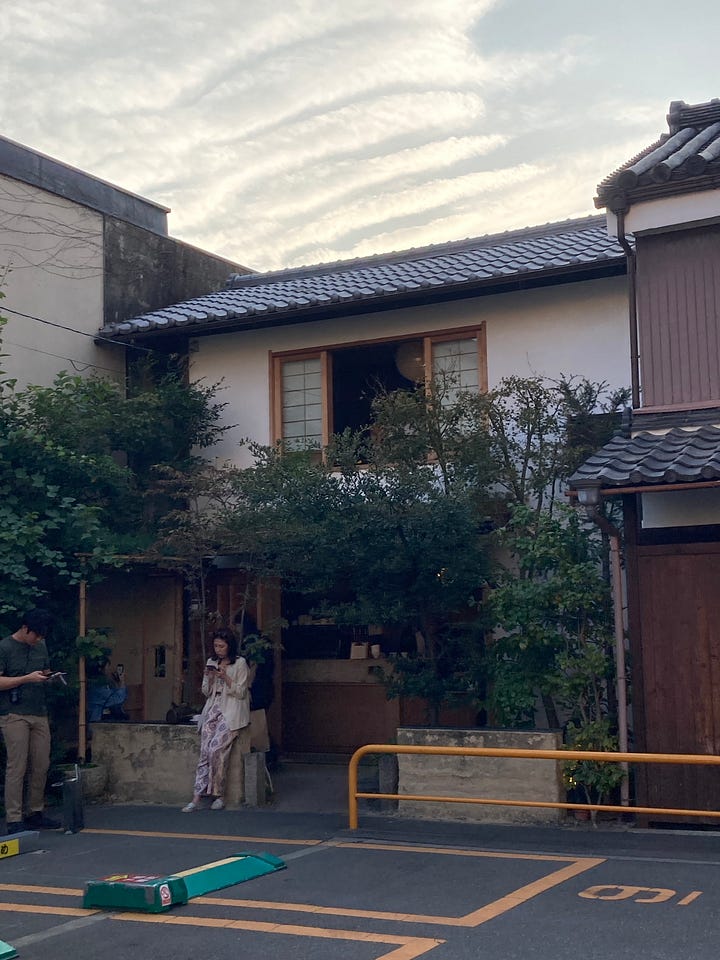

Sadly, though, ramen cannot cure everything. I stopped at a pharmacy afterward to buy some medicine. As soon as I approached the register with my cold and flu pills, a pharmacist appeared with a large binder in various languages – essentially filled with warnings about drug abuse. She told me, in English, to take three pills three times a day. That seemed rather excessive, so I checked the label with my translation app when I got back to my ryokan: nope, she was right! Japan, as a nation, is extremely cautious (and punitive) about drug usage, so I figured that the dosage of each pill was quite small. But it seems counterintuitive to advise taking more pills, more times a day: wouldn't this get some people attached to the sensation of pill-popping? No matter. When taken as advised, the pills worked their magic, and within a day, I was cured.
Friday, October 20th
My last morning in Kyoto, breakfast was prepared by the male owner of the ryokan, who could speak some English. It was interesting to observe how the couple’s breakfast-preparation styles differed: he made scrambled eggs with small curds, potato soup, and no veggies or rice balls. All good though!
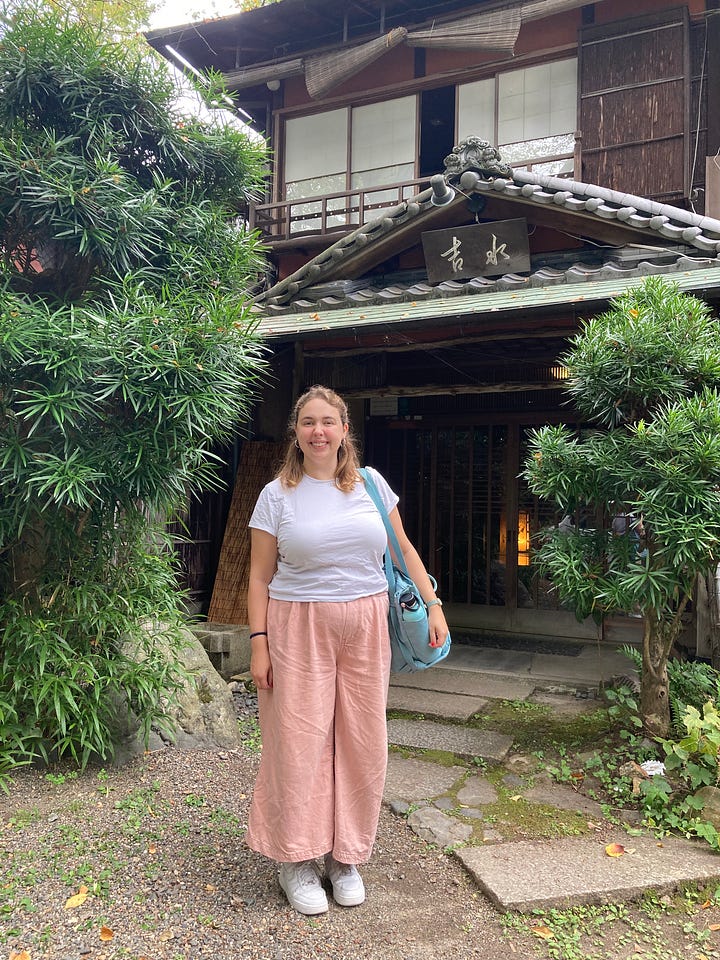
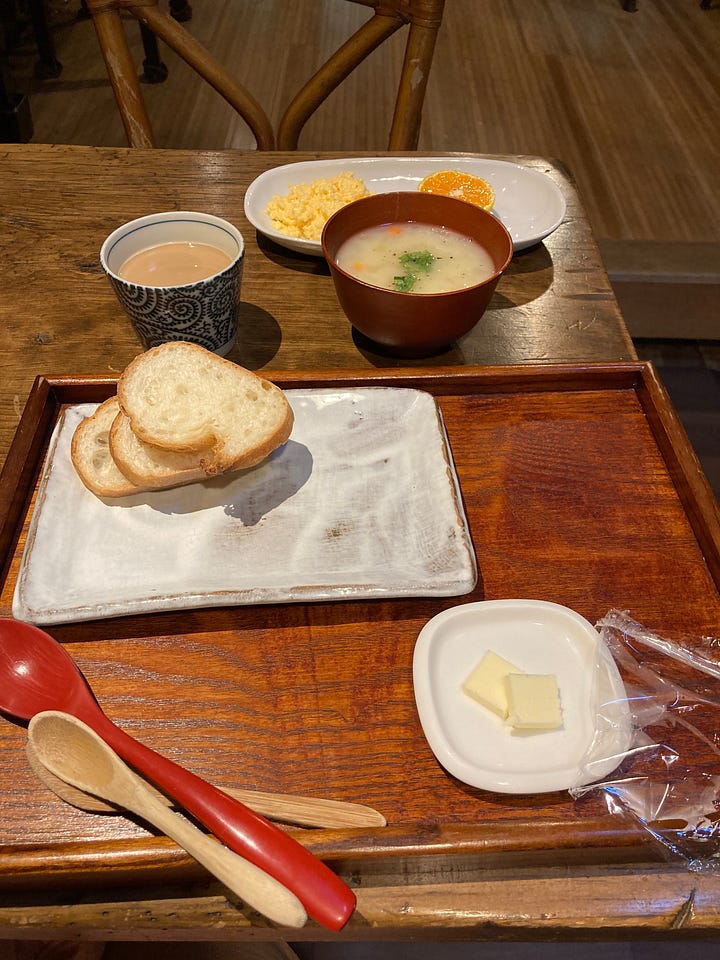
I had a glorious half-day exploring some of the temples around Higashiyama – stately Nanzen-ji, with its impressive gate and mysterious Romanesque arches; Zenlike Eikan-do, where I was finally able to see the first, flame-like bursts of fall colors; and, after a walk along the Philosophers' Path – barren this time of year – the lovely Ginkaku-ji, which, despite its nickname, is not actually silver (though the gorgeous rock gardens and bamboo forests nearby are). This part of Kyoto was quieter than I expected it would be, given its number of sights, and I relished that fact: walking became its own form of meditation, and I probably went the whole morning without speaking to anyone.


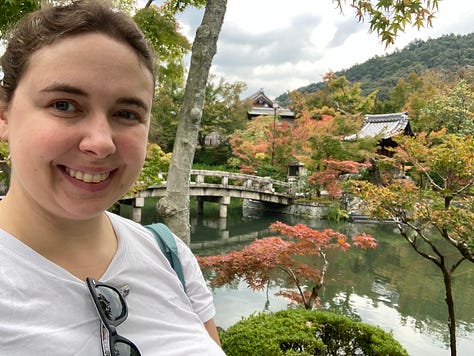
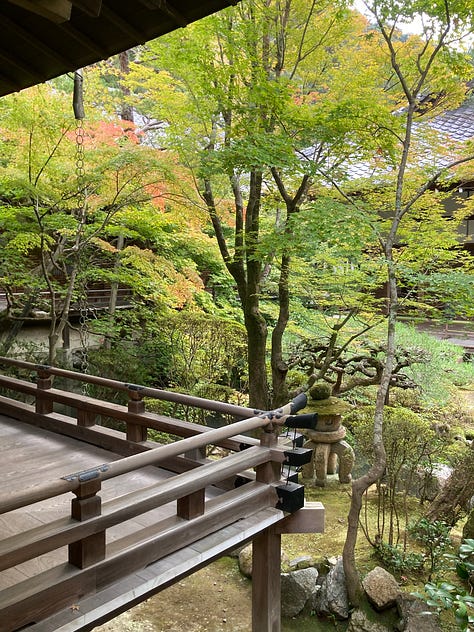
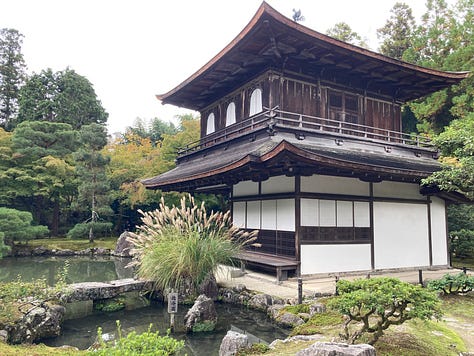
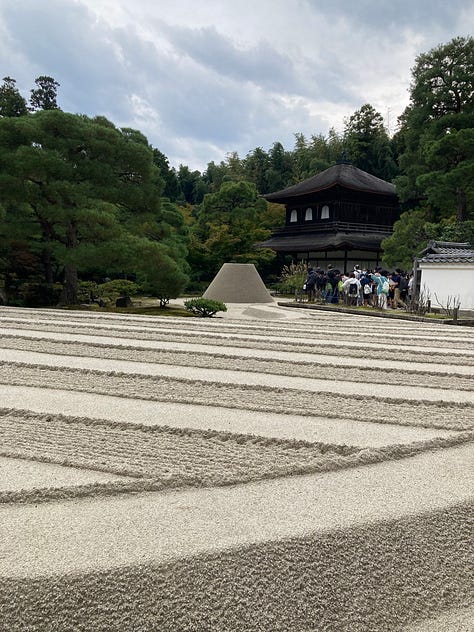

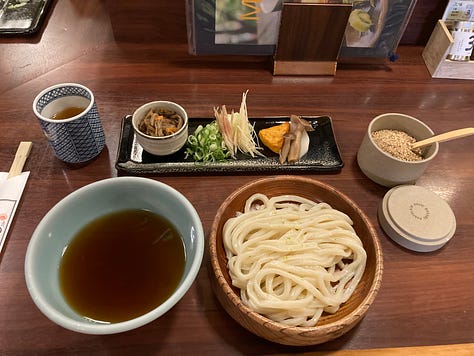
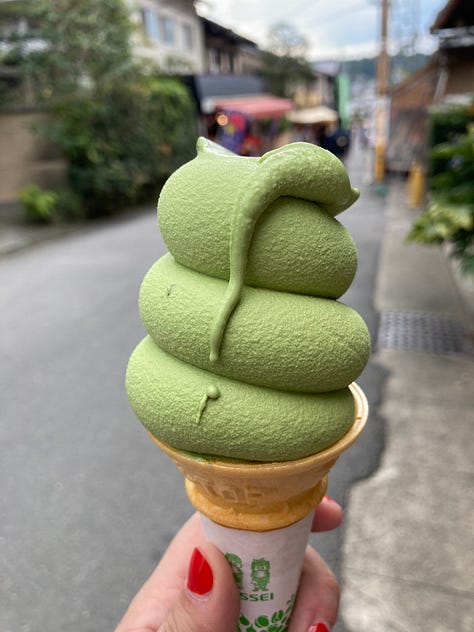
Lunch was just off the Philosophers' Path, at Omen, a well-known udon shop. I ordered the only vegetarian dish in its cold form. The broth and udon was accompanied by a pristinely sliced and organized array of mountain vegetables: scallions, mushrooms, some sort of grassy radish, and a single triangle of fried sweet potato. As I ate, I watched a woman methodically prep the vegetables for each dish – this, too, an act of meditation, maybe for us both.
This was all followed by one last matcha soft serve for the road. I returned to the ryokan to get my belongings and charge my phone. Unfortunately, by the time I was meant to leave it was pouring, so I had to skate down the hills by Marayuma Park with my luggage in both hands, sans umbrella.
My next destination was Nara, about an hour away by train from Kyoto. It's well-visited by tourists, but it had a particular hold on me because of the Nara Hotel, a beautiful, Taisho-era building that has hosted an array of Japanese and foreign dignitaries, celebrities, and the like. Marie had visited a few years ago and recommended it to me, based on our shared interest in this sort of history – when Japan's elites were, in various ways, orienting themselves more towards the U.S. and Europe while also remaining deeply invested in Japanese aesthetics. Staying at the hotel, which abuts Nara's famous park, was a splurge – to the degree where I could only, at a stretch, afford to stay in the more clinical "new wing" – but it was worth it. That evening, I took a self-guided tour of the historical wing, and lingered over the artefacts encased throughout the building: paper advertisements for the Nara Hotel, a timeline of famous guests, an old piano played by Einstein. Interestingly, as far as I could tell, I was the only foreign guest at the hotel; it was otherwise occupied solely by older, well-off Japanese couples. I wondered whether there was something to the hotel's position at the crossroads of history –its embodiment of a certain kind pre-war nostalgia – that perhaps appealed more to Japanese of a certain generation than foreigners who might otherwise covet luxurious experiences.
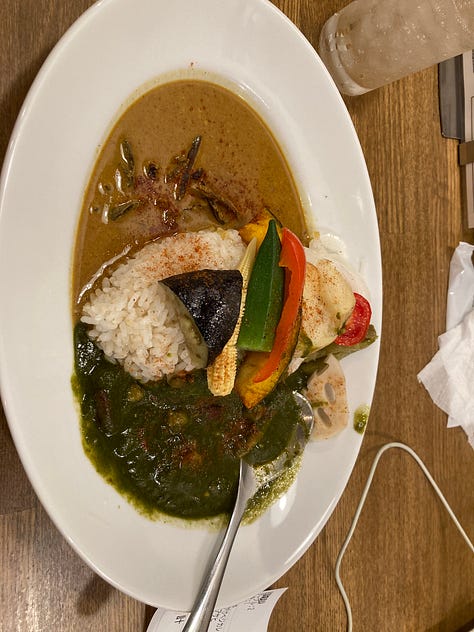
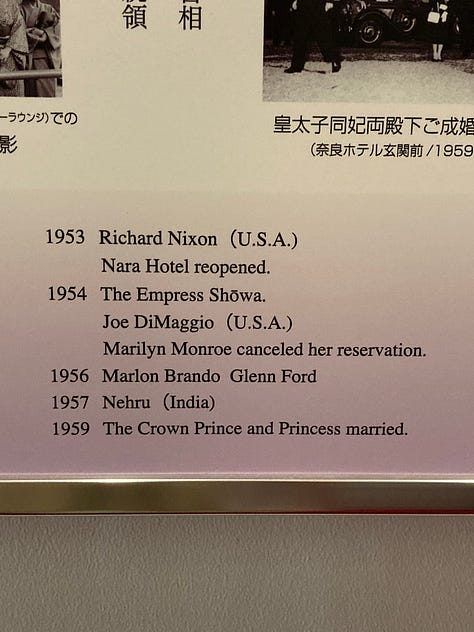
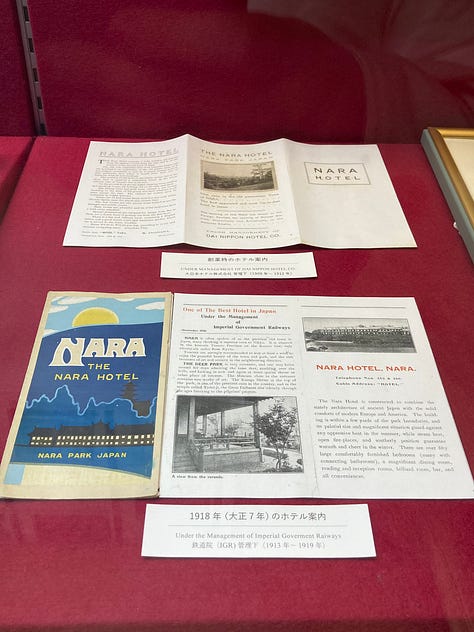
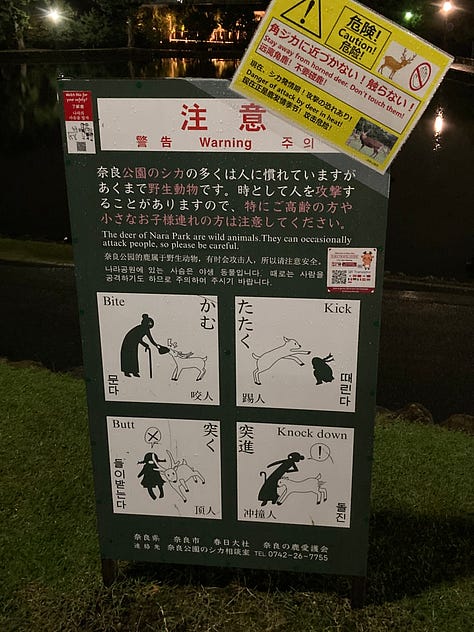
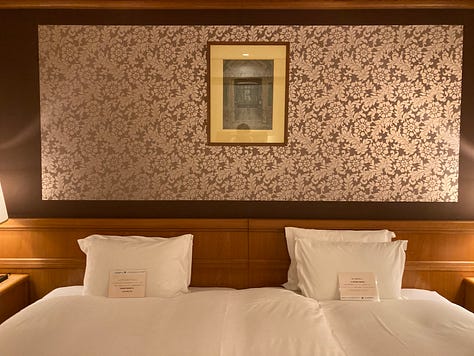
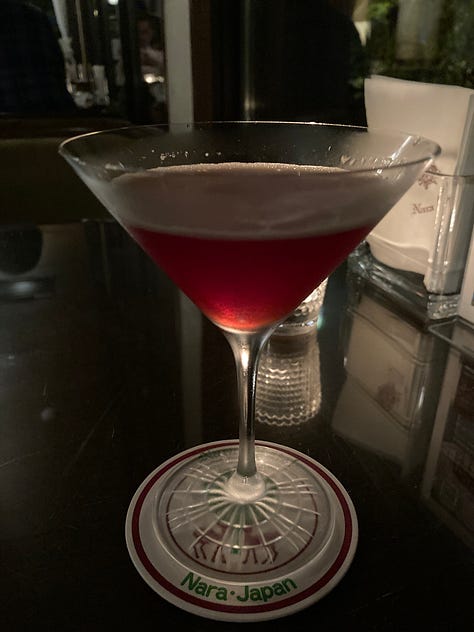
Nara isn't exactly a nightlife city: I went out around 6pm to find dinner, only to find that (especially in the rain) it was emptied of tourists. I had a modest meal at Wakakusa Curry, which was in the covered ginza in town. The vegetarian duo – half regular curry, half spinach curry over rice – was fine, but strangely nutty in taste and texture. For the only time in my Japanese culinary adventures, I found myself thinking that I (gasp!) could make an equally as delicious version at home. (I make my own Japanese curry blocks, using a spice mix from cookbook author Sonoko Sakai mixed into melted butter and flour.)
After a nice cocktail, akin to a Negroni, at the old-fashioned bar, I tucked myself in. They had put two double beds together for me – making quite possibly the largest bed I had ever slept in!
Saturday, October 21st
I refused to pay even more money to Nara Hotel for its breakfast, so I set out into town – as deserted as the night before – for some food. At Mia's Bread, I bought a coffee to drink then and a sandwich (raw vegetables stacked with a square of Kraft-like cheese – Japan's platonic form of the product– between two fluffy pieces of bread) for later; from Confection, a French-style bakery, I bought a more-than-decent pain au chocolate. It had been so long since I had had a sweet for breakfast, and I must say, I had been secretly craving it.
The tourist trail through Nara is well-trodden. I first went to Kofuku-ji, an impressive temple in the middle of town. Unfortunately, I was for the first time felled by Japan's dearth of trash cans: I had all my breakfast rubbish in my hands as I began my journey through the hordes of Nara deer in the park. This, as you can probably imagine, is a recipe for disaster. The deer are extremely cute, but way too accustomed to humans. Anyone can buy "cookies" from stands in the park to feed to the deer, so they are used to following anyone around who might have something in their hands. More often than coos of delight, I heard people screaming as a deer got too close to them and their snacks, or trotted after a kid waving their trash. ("Kowai!" I heard one kid crying, as a deer approached him – "scary!" in Japanese.) For the next few hours, and all through lunch – when I ate my sandwich and a bag of chips on a hillside swarming with children and deer – I had to defend myself and my trash diligently.
I loved the deer and their big, sweet eyes, but they were at their most adorable to me when they maintained a sense of mystery, of distance: looking at me steadily from behind a stone marker, pausing for a single pet on the shrine staircase. I preferred them this way, as beings with a distinct inner life, rather than a single-minded desire to convince a human to give them a treat. It seemed that a lot of Japanese people agreed: at the glorious, overgrown Kasuga Taisha shrine, they would sometimes bow in answer to a “bowing” deer, treating each one as the spirit who inhabited the place.
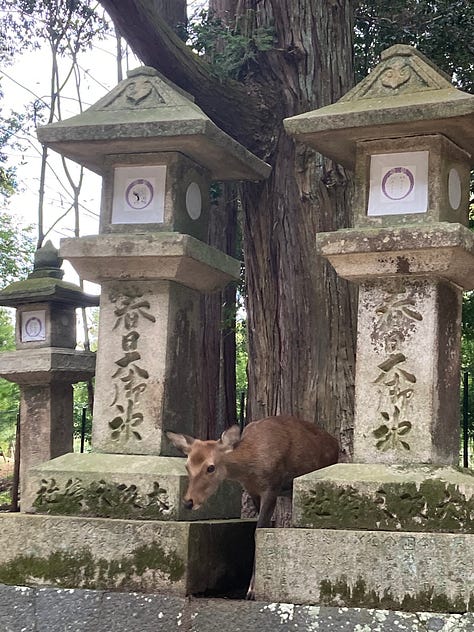
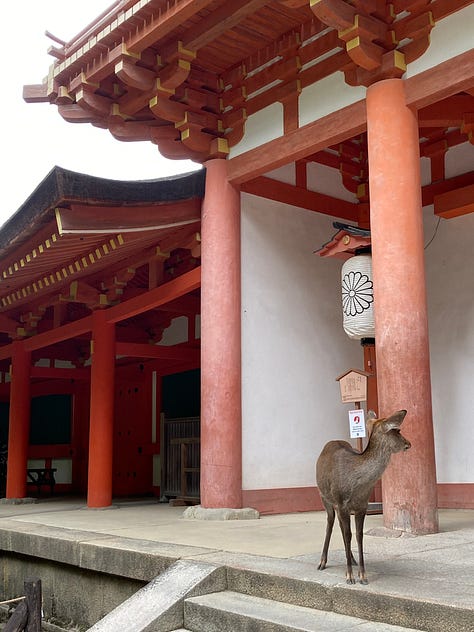
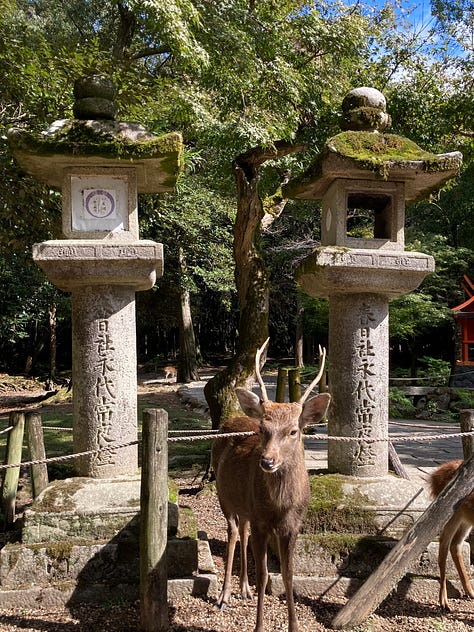
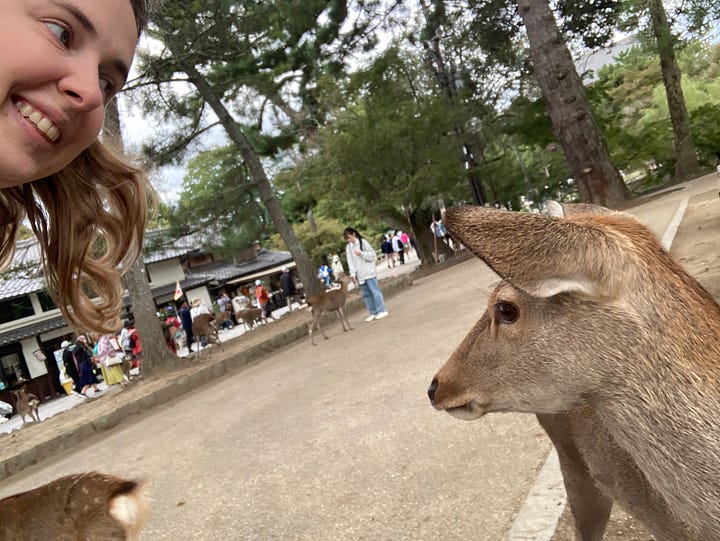
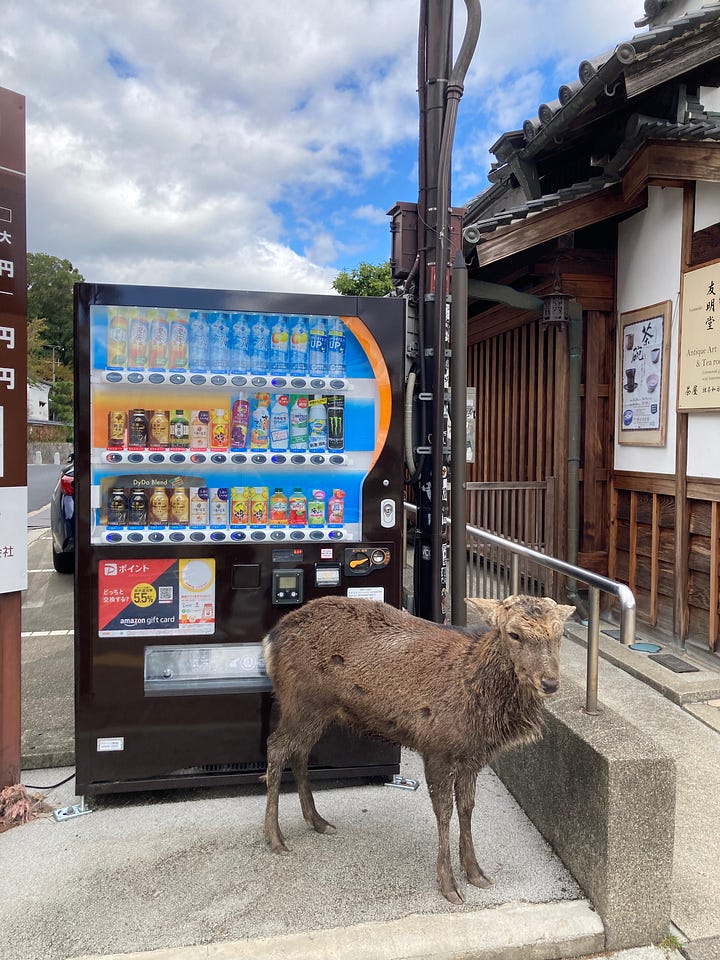
Both Kasuga Taisha and the nearby Todai-ji were magnificent – each one a favorite shrine and temple, respectively, of the whole trip. I was so moved at Kasuga Taisha by the layers of the complex, by its complete harmony in nature, that I made my first prayer of the trip. Todai-ji is home to a bronze Buddha that’s as large as a mansion; I couldn't help but marvel at the minds and hands who brought such a creation into being.
I returned to the town center along a wooded, monumental path, feeling a bit dazed, as one might when they have had a spiritual experience (and also walked 25,000 steps a day for a week straight). For once, I decided to jump in a long line and see what it got me: in this case, a steaming hot mochi, filled with red-bean paste and covered in a sort of graham-cracker-like golden dust. I had never had mochi warm before – it had the wobbly, silky texture of a barely cooked egg, and its gooey sides threatened to slip out of its paper shell.
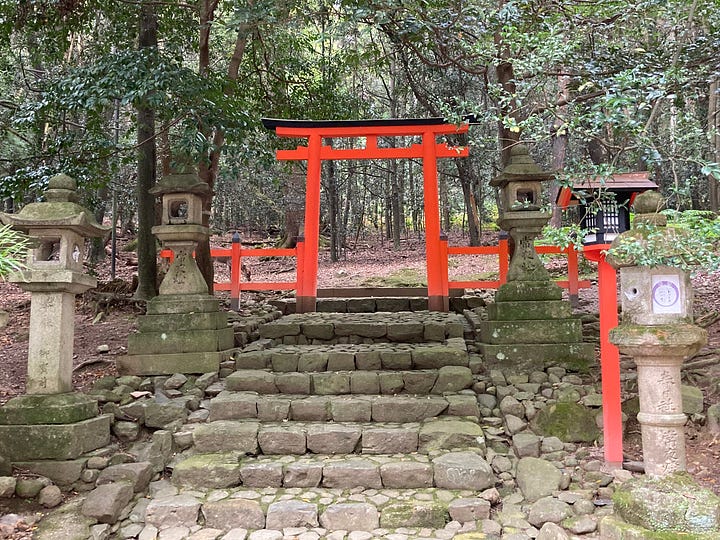
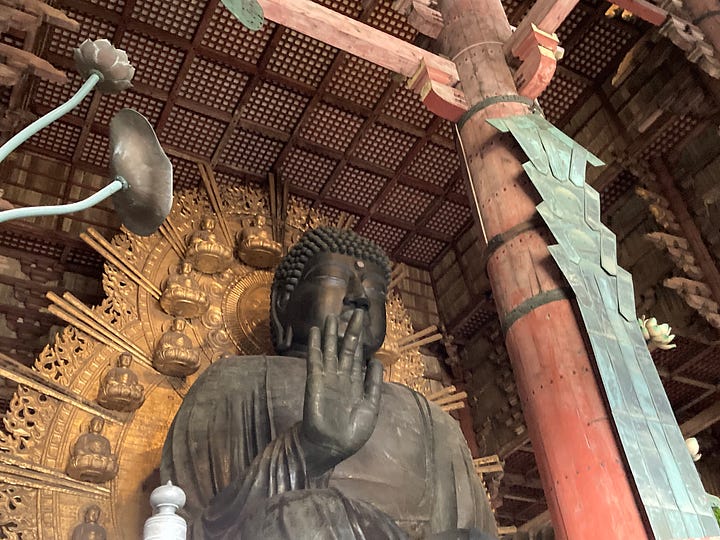
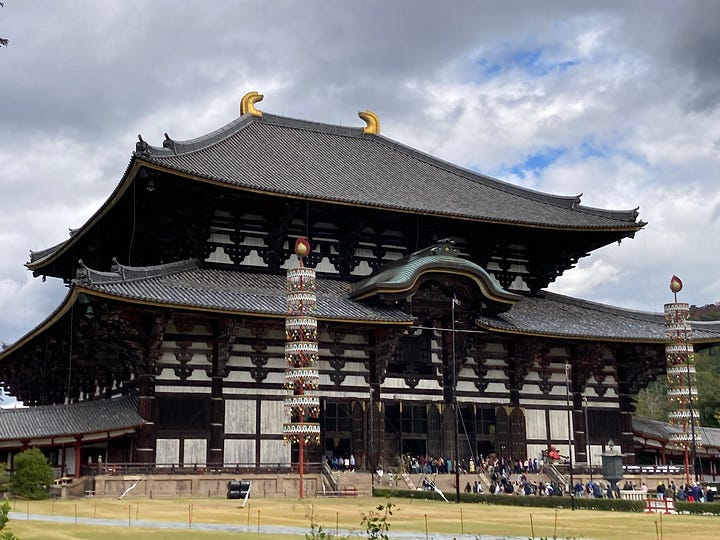
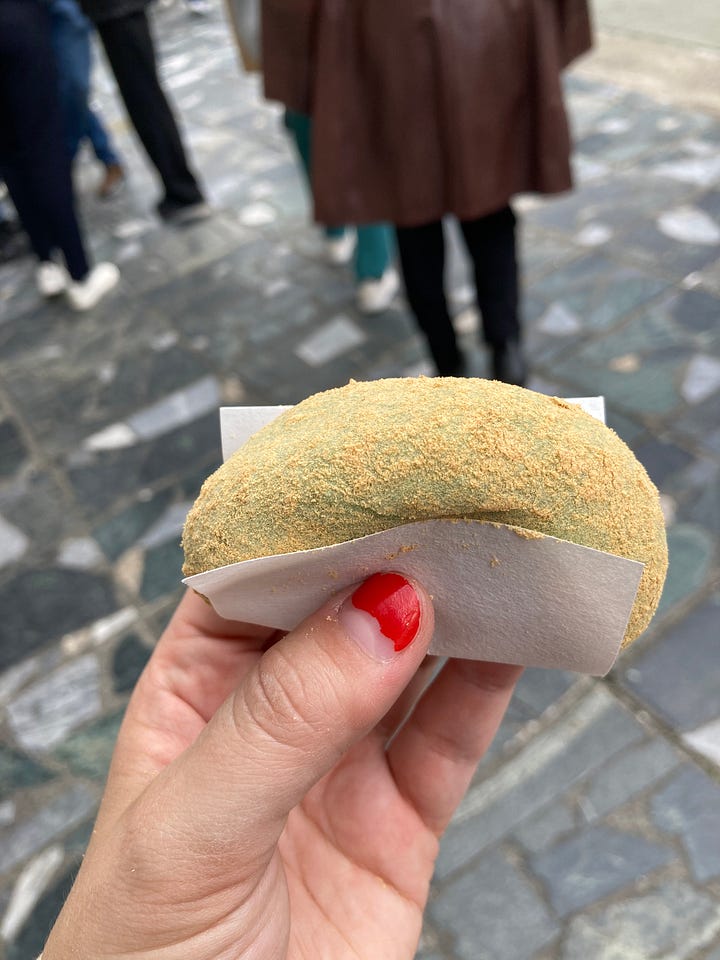
The hotel was able to take me and my bags to the station, where I caught a local train back to Kyoto. After being in such peaceful, if nominally crowded, surroundings all day, the hustle and bustle of Kyoto Station was a shock. Every time I entered a shop to look for a snack for the shinkansen ride back to Tokyo, I felt almost swept away by the travellers looking for heated bento boxes. Much to my chagrin, none of these boxes were veggie-friendly, and there weren't even veggie onigiri for me to eat. So I settled on a Calpico – a milky-toned water, with the sprightliness of Gatorade. On the train ride, I napped and read "The Makioka Sisters".
Marie welcomed me back to Tokyo by locating me (somehow!) in the chaos of Tokyo Station. We grabbed some tantamen at T's Tantan – a vegan tantamen shop within the station itself. I got the black sesame one, which was nice and spicy, though I somewhat resented the giant scoop of fake meat placed in the center, as well as the corn swimming throughout. (Both are not always my thing, texturally.) Above all, I loved the transience of the space: there's nothing quite like eating in a station with a friend, talking about books, about the relationship between Japan and the world, about your own solo adventure, for it to sink in that you've finally made it to where a place you have always wanted to go, and that it is filled with as much beauty and complexity as you could have hoped for. Naturally, a lot of pleasures and frustrations alike come from food.
Eventually, there will be a part 2 of this Grub Street Diary, chronicling the second week of Kylie's trip.





